PRO ARB
PROFESSIONAL TREE CARE FOR TREE SURGEONS




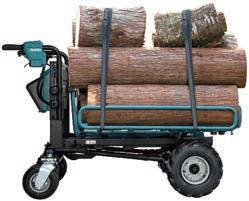
X2 (36V) LXT WHEELBARROW: DCU604

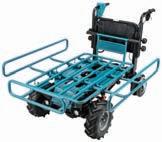
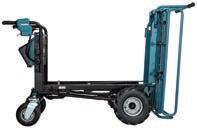




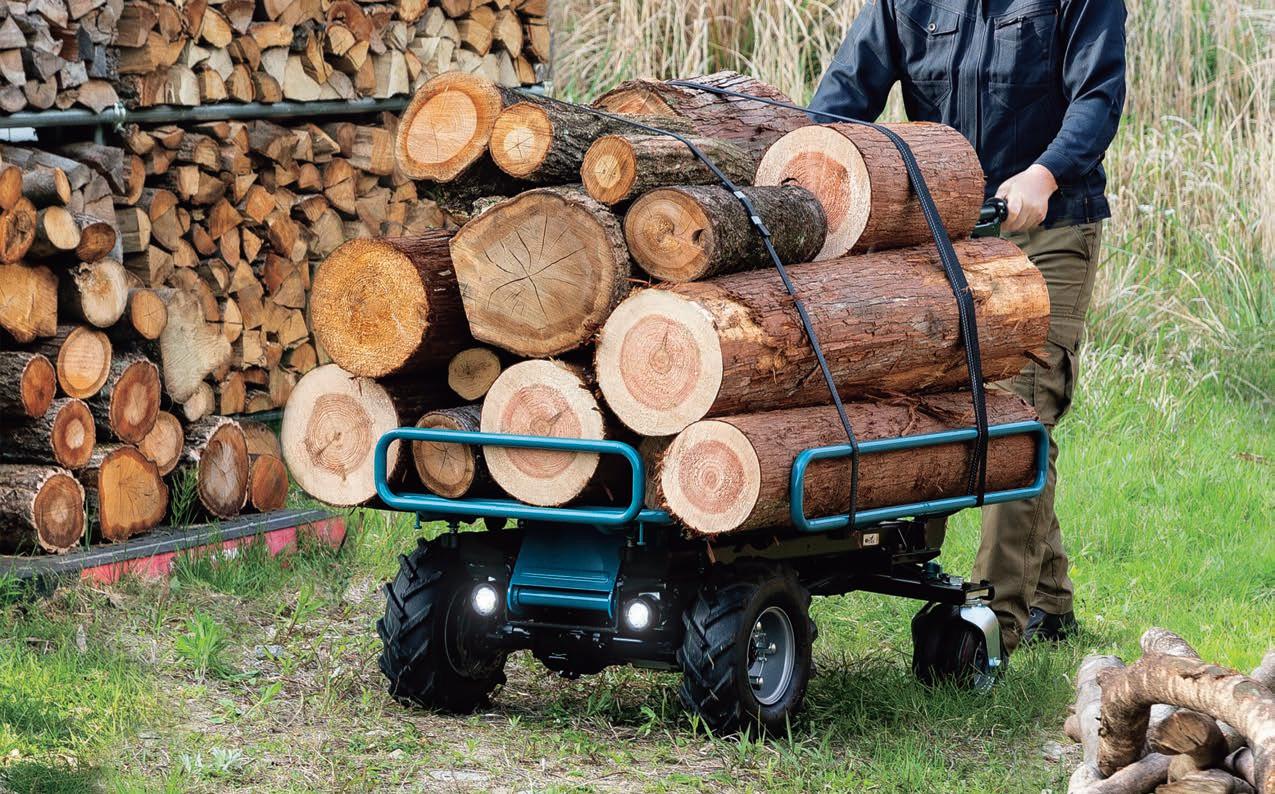
4 Wheel battery powered wheelbarrow powered, Pipe frame carrier Ideal for container boxes or bagged, materials. Telescopic loading platform, 300kg load capacity, Three forward speeds and one reverse, Variable speed control by trigger, Equipped with electric and electromagnetic brakes on top of hand lever operated mechanical brake, Headlights, taillight warning beeper and level gauge, Swivel lock fixes the direction of rear tyres, Double tyres (rear wheels only), each rotates, independently improves swivel performance, Manual dump unit, High unloading efficiency. Swivel range of dump unit 90º, Soft start, Constant speed control, Hand brake lever, Child lock key. Max Loading Capacity 300kg on flat ground, Max

When it comes to arb, there is no one size fits all. Whether someone has a passion for climbing or for the intricacies of a complex survey, there is work for all seasons and all kinds of people.
Our profile on VMS on page 20, features department head Steve Procter who describes a young business that is setting the standards in higher risk arb, such as alongside railway tracks and on water. Meanwhile, consultant Mark Chester, who runs Cedarwood, is not
only a planning expert, but also acts as an expert witness and is an author too –check out page 14.
This is a sector that, like trees, offers almost infinite variety and it deserves to be more in the spotlight, so the new Lantra awards, covered on page 18, should help play a valuable role in raising awareness.
Our kit pages are always packed with the latest equipment. From Bobcat’s skid steer loaders to Makita’s motorised wheelbarrow, there are as ever, pages of tempting machinery on offer. Meanwhile,
our Meet the Supplier feature on page 26 presents leading finance broker Arblease, which enables many arborists affordable access to exactly what they need.

I hope you are enjoying plenty of summer sunshine – as well as this latest issue of Pro Arb.
EDITORIAL
Features editor –
Rachel Gordon proarbeditor@eljays44.com

Head of content –
Nina Mason nina.mason@eljays44.com
Commissioning editor –
Sam Seaton sam.seaton@eljays44.com
Senior subeditor –
Katrina Roy katrina.roy@eljays44.com
ADVERTISING
Sales manager – Chloe Holbrow chloe.holbrow@eljays44.com
Tel: 01903 777 585
Account manager – Russell Eales russell.eales@eljays44.com
Tel: 01903 777 582
Sales executive – Lewis Everle lewis.everle@eljays44.com
Tel: 01903 777 588
PRODUCTION
Design – Kara Thomas
Printed by Stephens and George Ltd
Published by ©Eljays44 Ltd
CIRCULATION
Subscription enquiries –Tyler Gould tyler.gould@eljays44.com
MANAGEMENT
Chairman – Jim Wilkinson
Editorial director – Lisa Wilkinson
Managing director –Jamie Wilkinson
FOLLOW US ONLINE proarbmagazine.com
Follow us on Twitter @ProArbmagazine
Like us on Facebook
Proarbmagazine
Connect to our LinkedIn group Pro Arb UK
For careers in arboriculture and horticulture go to: horticulturecareers.co.uk
If you would like to send us press releases to post online, please email: content@eljays44.com
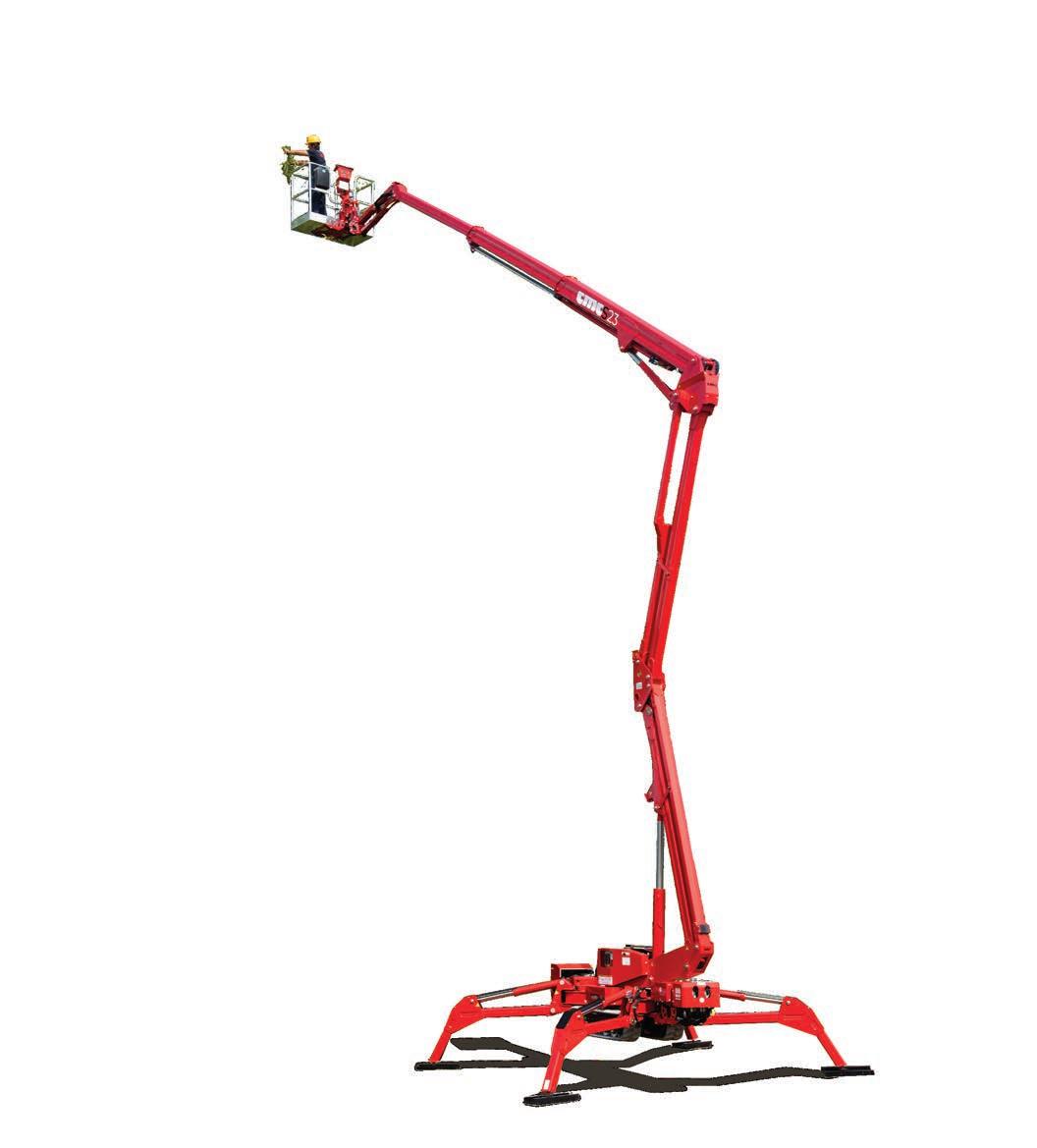
6 11 14 16 18 20
Check out the latest updates from around the arb world
News extra – tackling the great spruce beetle
Advances are being made at Scotland’s Dawyck Botanic Garden
Interview – Mark Chester
The multi-talented consultant from Cedarwood is a leading UK tree specialist

Tree health – expert view
Bartlett’s Dr Luke Hailey on the water retention properties of Tree Diapers and Gator Bags
Awards – a new event to celebrate learners
Lantra and Landex announce the Landbased & Environmental Learner Awards
Department head Steve Proctor on effective working in some of the most challenging circumstances
Wildlife rescue –saving young owls

Arborists step in to protect threatened birds
The Woodland Trust’s major project will transform the Dales and boost the environment
25
Up close and personal with Makita’s new electric wheelbarrow
26
Meet the supplier – Arblease
Making kit dreams a reality with affordable finance
28
Harness ON from Nationwide Platforms
An innovation to improve safety during MEWP use
30
Top tips – tree planting
Guidance from Tubex on giving saplings the best possible start
33 34
Skid Steers – Bobcat case study
HTC Arbor Services has taken on new on skid steer loaders, mini-excavators and a range of attachments
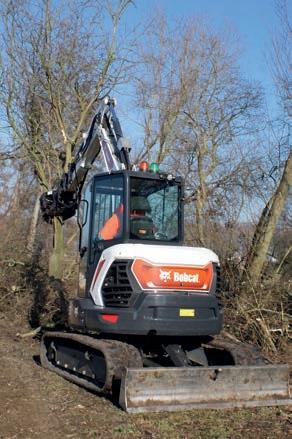
GTM Elephant’s Trunk harness
Ease the strain and work faster when hedge cutting
36
Green Line Arb’s new launch is aimed at the arborist and landscaper markets
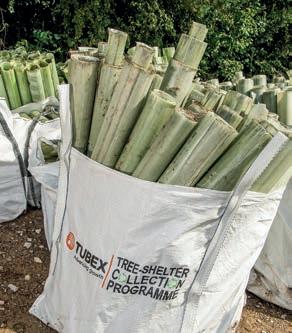
37
Is your firm ready to do more?
39 43
Ezytreev on parade
Meet the market leader for data collection, inventory analysis and tree maintenance
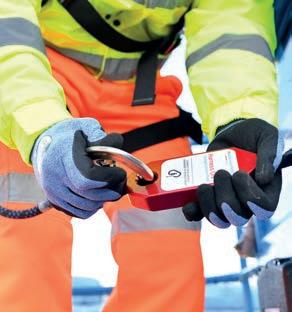
Five minutes with Sean Duffy
Get to know Lantra’s head of industry partnerships for arboriculture
Brighton and Hove Council is taking part in a programme to inoculate some of the city’s trees, with this being administered by Bartlett Tree Experts.
Around 200 elm trees in a number of parks are to receive the treatment in an attempt to prevent them catching Dutch Elm Disease. One of those will be the remaining ‘Preston Park twin’ – this is a historic tree and had stood alongside another elm that was planted in 1613 during the reign of James I. This had to be felled in 2021 after succumbing to the disease.
The treatment should protect trees from the disease and needs to be administered annually. The treatment is an organic product called Dutch Trigg and it is injected directly into the trunks of elm trees using a specialist tool. This means that the newest growth ring in the tree trunk can be pierced without damaging older rings, which prevents the spores of previous infections being released and infecting the tree again. Trees need to be treated in spring before leaves reach full growth and the beetles that carry the fungus emerge.
brighton-hove.gov.uk
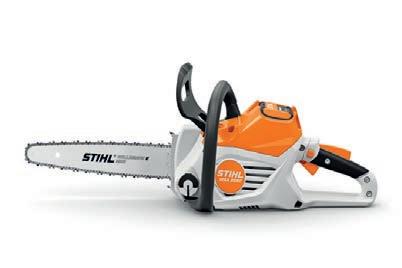


Stihl has improved its cordless chainsaw MSA range with upgraded versions of the AP System MSA 160 C-B, MSA 200 C-B and MSA 220 C-B.
It now offers professional users a new streamlined design, improved battery performance, faster cutting and enhanced operational features.
The MSA 160 C-B has been made more powerful than the previous version with a larger motor and compatibility with the recommended AP 300 S AP System battery, which ensures an increased electrical output of 1.5 kW for quicker cutting performance.
In addition, the enhanced MSA 220 comes as standard with a 3/8P pitch and 1.1mm gauge PS3 PRO chain, which improves cutting performance by up to 20% because of its narrower kerf.
The new chain has been specifically designed for use with Stihl’s new Light 04 1.1mm guide bar that allows more cuts to be made per battery charge. The MSA 160 C-B and MSA 200 C-B feature a 1/4P chain for smooth and precise cuts.
All three models now benefit from numerous upgraded operational feature, these include improved visibility of the chain oil level for faster checks, a thumb lever and OPC starting switch
for increased comfort and safety. There is also a soft rubberised grip and optimally balanced handle position for maximum control.
All new models feature quick chain tensioning for fast and toolless replacement or tensioning of the chain, as well as bayonet style oil tank caps which can be opened easily while wearing gloves.
Stihl has also upgraded its AP 300 S battery to include built-in connected technology, allowing professional users to monitor the working time of the battery and manage their machinery fleet efficiently.

The updated addition, which is compatible with all cordless tools in the professional AP System, can also transmit useful information via Bluetooth to the Stihl Connected App. stihl.co.uk
Leicestershire Council is engaged in a project to plant 700,000 trees across the county and now reached the 250,000 milestone.
The local authority says when it reaches 700,000 this will be around one tree for each resident. The council is planting trees directly and working with other partners, including applying for funding and also giving away free tree planting kits to residents. Community and nature groups are also being encouraged to
join the initiative. Once a tree is planted, it needs to be recorded using an online form and the numbers will show on an interactive tree map.
The council is also working with local people to set up a community tree nursery in conjunction with the National Forest – this will collect seeds and grow 20,000 trees that will then be planted as part of the project. leicestershire.gov.uk
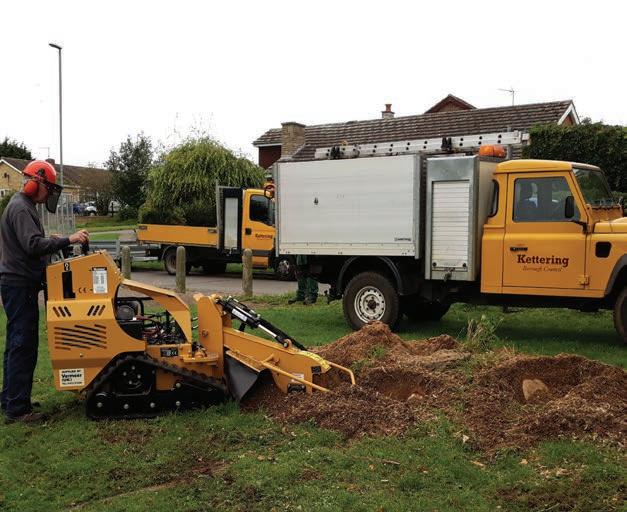

















our future. We look forward to supporting our existing customers while continuing to develop industry-leading new products, designed to perform without compromise.”
New dealer update GreenMech has announced a reshuffle of its dealer network, with the introduction of a number of new sales, service and parts partner across the country.
Wood chipper manufacturer GreenMech is celebrating 30 years in business.

The company says its success is down to innovation in manufacturing and a focus on service and support. Since inception in 1993, the company has been based at the Mill Industrial Park, Alcester, Warwickshire. The business was founded by the current chairman, Tony Turner.
Over the years, some 14,000 products have been designed and manufactured, with more than half of the total product exported to customers globally.
There are some 15 models available with chipping capacities from 100mm up to 220mm. The business also developed the GreenMech disc-blade chipping system, turntable technology and the SAFE-Trak and SURE-Trak systems for embankment safety.
Jonathan Turner, son of Tony and current GreenMech managing director, said: “We are incredibly proud of our achievements but are even more positive and excited about
Full distribution arrangements have been reached with Ross McTurk Engineering, Silvestria and Griffin Machinery Solutions, while MKM Agriculture will now be providing after-sales support to customers in Northamptonshire, Buckinghamshire and Bedfordshire and Hunts Engineering covering customer support across Oxfordshire.

GreenMech has also announced the appointment of two new supporting dealers. Bedfordshire’s MKM Agriculture will be providing parts and servicing to those in the surrounding counties of Northants and Buckinghamshire, while Hunts Engineering will be looking after customers in Oxfordshire from their depot in South Warwickshire. greenmech.co.uk
The Woodland Trust has spoken out against the government’s planned new road schemes. Analysis by the charity found new road developments would directly or indirectly affect 106 ancient woodlands, while a further 83 ancient woods were predicted to be affected with some 82 ancient and veteran trees to be felled over a decade of road investment. It is now calling for an urgent rethink to protect irreplaceable habitat.
The government’s National Networks National Policy Statement for transport infrastructure projects has been revised to take more account of the climate emergency. However, the charity says the draft policy only pays “lip service” to addressing the impacts of roads on the climate by requiring carbon assessments for schemes. Despite this, the statement also notes emissions on their own are not a good enough reason to refuse permission for a new road.
Naomi Tilley, lead campaigner at Woodland Trust, said: “Avoiding harm must be at the heart of decisions about development to ensure we do not repeat the devastating mistakes of past projects.” woodlandtrust.org.uk
A property developer is being investigated by the Forestry Commission after trees were felled at a site in the village of Trowse near Norwich, which was being prepared for new home building. The trees were felled by Serryus Propery Company at the site of a former industrial site where some 670 new homes will be built.
South Norfolk Council confirmed an investigation was under way and the Forestry
Commission, which has been given greater enforcement powers by the government, is involved. A Forestry Commission spokesperson said: “We have carried out site inspections to undertake measurements, take photographs and make an assessment to see if any breaches of the Forestry Act have taken place.”
Felling trees without the necessary licence can carry an unlimited penalty upon conviction in a Magistrates Court. Provisions within the
Environment Act can increase this penalty to an unlimited fine, set at the discretion of the court.
Local residents were reported as saying they were distraught to see so many trees felled and district councillor, John Overton, has concerns. He said: “I had been working closely with the developer but what they have done, there is no excuse for it.”
gov.uk/government/organisations/ forestry-commission
power when needed. With two output settings – 500W or 350W, the inner heating area is large enough to fit most microwave containers and provides a continuous heating time of up to 37 minutes, when used with two BL4080F batteries at 500W output.
Law firm Farrer & Co has warned landowners that trees must be managed to avoid criminal and civil prosecutions.
The microwave – MW001GZ – is designed for portability, allowing users to make hot meals in minutes when on the jobsite. The 8-litre capacity oven is powered by one or two 40VMax XGT batteries and is designed to utilise the power sequentially for continuous
The appliance features large carry handles for easy transportation and is supplied with a carry strap. As part of Makita’s XGT battery platform, this product fits in seamlessly with Makita’s XGT power tool collection, enabling users to swap batteries between tasks.
Kevin Brannigan, marketing manager at Makita UK, says it is “the perfect jobsite companion, affording users with a hot, microwaved meal or drink in minutes.” makitauk.com


VMS, which provides de-vegetation services, has helped wildlife through a biodiversity project when working on the Kettering and Market Harborough rail line in the Midlands.
VMS was working for SPL Powerlines on behalf of Network Rail, and created both a safe corridor for the electrified railway and reinstated a wildlife habitat with a minimum 10% uplift on what was previously there.
“We adopt a real world approach to our ecological works to provide solutions to our clients while observing current best practice and legislation,” said managing director Rob Mallett.
The work required a vegetation clearance of 6.5 metres from the tracks for safety purposes and scrubby undergrowth was cut back. But where traditionally these branches would have been chipped and returned to the ground adjacent to the rails, the team


avoided this since it can encourage bramble and other undesirable species to grow, smothering higher value habitat species such as grassland and wildflowers.
Instead, the wood chip is taken away for use as biomass. Rob said: “The key thing for me is that I am putting something back. In the past you’d just have miles of wood chip spread out, whereas with our change of approach you are creating good high value wildlife habitat.
“Just recently one of our teams came across over 100 metres of Viola riviniana growing just two metres from the running rail. This plant is very important for several fritillary butterflies because they lay their eggs on it.” vmsltd.net
It said recent cases this year brought by the HSE include Newcastle City Council being fined £280,000 because of the death of a six year old who was hit by a falling tree in a school playground. The tree had decayed and the council had failed to deal with it.
BUPA Care Homes was fined £400,000 after an eight year old girl was seriously injured when a tree fell on her. The accident occurred at Oak Lodge Care Home in Bitterne Southampton. The girl was passing the property when a lime tree fell on her and she needed to have her leg amputated. The tree was affected by a fungal disease.
The care homes provider pleaded guilty after it failed to provide a system to manage trees on its properties. The HSE said both incidents were “avoidable”.
The prosecutions were brought under the Health and Safety at Work Act.The cases found there had been a lack of the risk assessment, proactive surveying, inspection, and monitoring required to identify any necessary remedial actions.
Farrer & Co said landowners need to employ a ‘competent person’ with the training, skills and experience to identify and categorise trees according to the level of risk they present, using a zoning system. This risk will be affected by the location and nature of the trees.
A system should also allow people to report tree damage they have seen and to trigger additional necessary checks such as after a storm. Records should be maintained and monitoring needs to be in place to ensure that the tree management system is implemented properly. farrer.co.uk




ALTHOUGH INFESTATIONS ARE INCREASINGLY COMMON, EXPERTS AT SCOTLAND’S DAWYCK BOTANIC GARDEN HAVE A PLAN TO COMBAT THIS VIRULENT PEST
Acentury’s old Brewer’s weeping spruce (Picea breweriana) was recently dismantled at Dawyck Botanic Garden in the Scottish Brokers – the tree was the victim of the great spruce bark beetle (Dendroctonus micans).
Rising numbers of infestations are affecting both private collections and the timber industry. But, despite the loss, there is some hope for a fight back against this particular predator.

Specialists at Dawyck, which is part of the Royal Botanic Garden Edinburgh (RBGE), are working to find a solution. They are examining sections of the once majestic conifer at the wellknown arboretum and also introducing the tiny Rhizophagus grandis beetle, which relies on D. micans as its only food source.

It is hoped that having knowledge of where and when the D. micans pest is moving, coordinated with controlled release of Rhizophagus grandis beetles could be an efficient and sustainable approach to an increasing problem.
RBGE is partnering on the project with Forest Research and Scottish Forestry, and all parities in turn are involved in a range of initiatives to implement safe biological controls.
Dr Matt Elliot, plant health and biosecurity scientist at RBGE says: “The impact of plant pests and diseases on RBGE sites and the wider environment has become one of the most pressing areas of our work. We coined the phrase D-Day, where D equals Dendroctonus, in relation to the removal of this particular tree, we are addressing a situation which, we believe, could be a turning point in our approach to one significant plant health issue.
Since identification of the D. micans pest at Dawyck in late 2020, the Garden’s Picea collection has become further infected. Significantly, of 329 Picea trees, 246 are of known wild origin, 95 are endangered and 14 are classed as vulnerable in their natural

“The Dendroctonus micans beetle tunnels into the bark of living trees to lay its eggs. The larvae feed on the living woody material, forming cavities which weaken the tree and can eventually kill it.”


He adds the species was known to be in the wider environment around Dawyck, so there was a strong chance it would arrive in the Garden and some form of action would be required. “Thanks to 30 years of work by Forest Research, we are now in a much stronger position with the development of an effective biological control, in the form of Rhizophagus grandis.”
Matt explains this species has an “extraordinary ability to locate its prey without posing any threat to trees or native beetles. While the process won’t eradicate the pest, it will keep numbers to a level where damage is reduced.”
habitats. The exceptionally dry summer of 2022 caused further stress on trees already weakened by the infestation and the need to find a resolution has intensified.
Garden curator Graham Stewart says: “Dawyck has a particularly fine collection of Brewer’s spruce, many dating back to the former estate owner and leading academic FRS Balfour who observed them in the Pacific Northwest of America and had seedlings shipped back to Scotland and planted out in 1912.
“Now, we live in a time of rapidly increasing threats to plant life. We need to search for answers, not only for the future of our own collections but for other gardens, estates and the wider countryside. Working with Forest Research and releasing just 25 Rhizophagus grandis in key locations allows us to monitor other trees, with the ambition that we can avoid the need for any future Dendroctonus micans related removals.”
For more information: rbge.org.uk/visit/dawyck-botanic-garden
The great spruce bark beetle infests and kills spruce (Picea) and pine trees (Pinus). Despite gaining the name ‘great’, adult beetles are only six to eight mm (0.25in) long and 2.5 to 3mm (0.1in) wide. While the beetle is a common pest throughout mainland Europe, it is not native to Britain. It is suspected that D. micans was accidentally introduced with a consignment of imported timber in the late 1960s or early 1970s. The first breeding population was documented in Shropshire in 1972. It then spread through Wales and western England, eventually expanding its range to southern Scotland, partly as a result of changing weather patterns. Its story demonstrates how the inadvertent movement of species is a key driver in biodiversity loss, not only for plants affected but also other species reliant on them. It is a situation predicted to get worse, with the number of recorded incidents rising dramatically.
The Brewer’s weeping spruce (Picea breweriana) is a distinctive tree from the Klamath-Siskiyou Mountains in the United States. In its natural habitat it is threatened by climate change. The heavy snowfalls to which it is well adapted are increasingly unpredictable, while its thin bark makes it particularly vulnerable to wildfires which have swept through Californian and Oregon forests in recent years. The Dawyck collection is well regarded as one of the finest collections in the country.
While the process won’t eradicate the pest, it will keep numbers to a level where damage is reducedDendroctonus micans larvae

Cedarwood Tree Consultants, based in Hereford, works with clients nationally on a range of professional services for companies and individuals including planning permission applications, BS 5837:2012 tree reports, tree preservation order disputes and expert witness services. This is in addition to those who may simply need advice about any tree-related matter.
The consultancy was founded by Mark Chester and has since expanded to work with a wide range of clients who include solicitors for insurance purposes, land owners, architects and residential property owners.
So, why did he choose to work with trees? Mark explains that he grew up in a farming family and had always felt a connection with trees, but did not know they could offer a career. “The only tree management role I knew about was forestry, which didn’t appeal.”
After leaving school, Mark studies for a degree in Amenity Horticulture at Pershore College in Worcestershire, but part way through, saw an advert for a tree officer position within a local authority, and he realised what he wanted to do. “I had to complete my degree first and then specialise. I did a National Certificate in Arboriculture and became a Certified Arborist.”
Initially, he gained experience within an arborist firm but says he quickly knew that he preferred “writing about trees to climbing.” Mark then taught Horticulture and Woodland Management at Hartpury College in Gloucestershire, before joining Dudley Council as tree officer in its planning department.

I had found my role. I have always been interested in the planning process and combining this with my love of trees was great
This was the job he had been waiting for. “I had found my role. I have always been interested in the planning process and combining this with my love of trees was great. The council paid for me to take the old Technician’s Certificate and Professional Diploma and I worked there for five years. I also reviewed the TPO database for Walsall Council and spent two years at Birmingham City Council managing their parks and street trees contracts.”
But, Mark was also considering starting his own venture. “I am the fourth generation in my family to run a business and I set the practice up in 2005, so that I could reach out to the private sector and work with clients to resolve their tree-related problems. Overall, I enjoy working with people.”
cases as an expert witness and the process interested me,” says Mark.
“I attended court as the expert when at Dudley Council for a TPO prosecution. I then explored further with expert witness trainer Bond Solon to become skilled in this area. I like exploring the key issues and presenting a report
accreditation, such as needing to be a Chartered Arboriculturist as well as having reports reviewed would help.”
He said this was a role for the Consulting Arborist Society, but clearly there is a place for this to become compulsory.
Cedarwood now operates across the UK and Mark has colleagues who help with ecology reports and a further new line of business are Landscape Impact Assessments, where Mark is able to put his degree in Landscape Horticulture to good use.
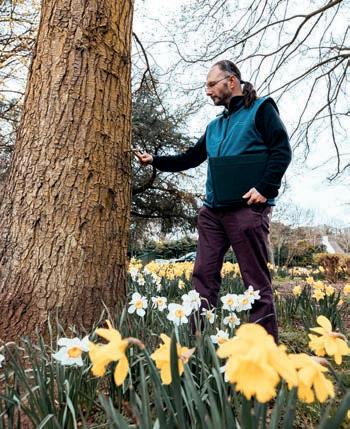
In terms of Cedarwood’s offering, the practice provides a full consultancy service from inspecting a single tree for safety or providing a report for a home buyer to working on planning applications, explains Mark. “For planning, we can work with clients from the earliest days of feasibility assessments through to identifying trees for retention and how to do this practically. We can also help with implementation of Tree Protection plans and I lead on the expert witness work.”
Being an expert witness is highly specialist and Mark says he developed knowledge to do this through advanced arboricultural training with David Dowson, who runs the Tree Life consultancy – he was involved with several

that is accessible and informative and while being in court is challenging, it is good to push yourself and be stretched.”
Mark continues: “There is something special about enabling others to resolve cases. Most of my work is writing the reports and I am independent in the process, with my duty to the court. However, a highlight is when I have enabled a client to resolve their issues.”
Mark also writes for a wider audience and says: “I love writing, especially about trees. I edited the ISA TreeLine magazine and was involved with the magazine for the Consulting Arborist Society.”
He adds that when running the Consulting Arborist Society between 2009 to 2020, he caught up with Peter Wells who founded the renowned nursery, Barcham Trees. “I realised that his life was notable and I wrote up an interview and two articles on developing a business. Later, I spent time getting to know him more and wrote a biography, ‘White Containers: The Peter Wells journey’.”
Mark has also been interviewed himself a number of times. “I love talking to people about trees! One surreal occasion was with Jeremy Vine for his BBC radio 2 programme. A legal case had reached the news involving two neighbours and an apple tree, and costs of about £250,000. I saw the news flash the night before and got a call that morning to talk about it.”
“There are people who write reports and offer advice, but are not sufficiently knowledgeable, including for expert witness work. More training and possibly requiring compulsory formal
For an arborist or a tree officer who wants to move into consultancy, Mark says there are opportunities for those who are willing to gain the qualifications and undertake the training. “I advise those considering a career to think about which part of the role they prefer. Some are happier being outdoors looking at trees, and others enjoy the report writing aspect. Tree officers are actually already in-house consultants for their local authority.”
Mark has also seen the rise of ‘tree activism’ where local people have risen up against felling, whether carried out by local authorities or developers. He says the key issue for both sides is “a lack of engagement with locals and a determination by decision-makers to proceed regardless. It’s important to listen and engage, and be prepared to change a decision if necessary.”
Working with trees remains a passion for Mark and he admits that even when he’s out for casual walks, he still finds himself distracted and taking a closer look at trees. He adds there will be the odd break this summer though when he will be doing more writing and also indulging in another passion – cricket – and following along with the events of The Ashes.
treeconsultants.org.uk
a highlight is when I have enabled a client to resolve their issues
Those who care for trees know a prolonged lack of water has serious consequences, especially for recently transplanted trees. So two options to look into are Gator Bags and Tree Diapers, both of which were developed in the US, and are available in the UK.
Gator bags are a slow release watering bag which can be filled quickly and left to slowly apply water. Tree diapers are a ring of woven plastic textile filled with absorbent material which soaks up rain or irrigation water. They absorb rain or irrigation water and slowly release it back to the plant when the soil dries and promote healthy outward root growth particularly in newly planted trees.
My colleague, Jon Banks, our research laboratory manager has been looking at how these two irrigation bag technologies compare.
Tree Diapers contain the same polymer found in disposable nappies, which when combined with potting medium can lead to increased root-to-shoot ratios. However, results can be variable if the water retaining gels get mixed into soils at planting. Yet, if the product is positioned directly above the root system of new or existing trees, there may be more potential. Manufacturers claim these products capture precipitation and irrigation, prevent runoff and slowly release water to the root zone.
Gator Bags are a controlled irrigation solution which can be installed during establishment or
dry spells to reduce irrigation run-off, soil damage and surface root exposure which may result from high flow-rate, direct watering.

Using Gator Bags has been shown to speed up watering times, while still allowing slow trickle irrigation over many hours. Recent potbased studies however, have suggested limited plant growth benefits are gained. Instead, primary benefits come from the ability to more rapidly fill an irrigation bag rather than causing run-off, or slowing those flow rates which subsequently increase time spent watering.
Pot studies, although useful, cannot appropriately account for run-off, wider water infiltration and natural tree root morphology.
In a small study, the impact of Tree Diapers were compared to Gator Bags, mulch and non-mulch watered controls. During a period of significant drought in the UK, newly planted pear trees were supplementarily irrigated with identical volumes of water.
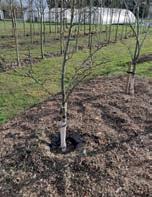
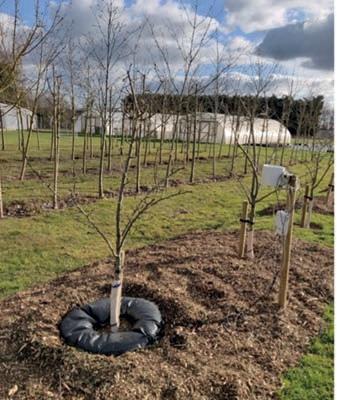
Gator Bags were filled with 20 litres of water and recorded to empty within around one to four hours. Tree Diapers were installed hydrated, at planting in March 2021 and the only supplemental watering occurred during a summer dry spell where water was poured into the centre of the donut-shaped product.
The Tree Diaper was installed with direct contact to the soil and mulch was applied on top. Any mulch in contact with the tree stem was removed. Using either Tree Diaper or a Gator Bag did result in better hydration compared to the control. But, no significant improvement was observed when using irrigation bags of any type when compared to mulch. An increase in worm counts was
observed in the Tree Diaper group in comparison to the control group, but no difference was observed between the other treatment groups.
The research demonstrated the widely known benefits of mulching with coarse arborists’ wood chip mulch, with a 5-to-10 cm application far outweighing the benefits derived from either the Tree Diaper or the Gator Bag. When the same volume of irrigation water is applied to mulched plantings, even with a slight slope in this trial, limited improvements in water relations are conferred by irrigation bags in this setting.
In future studies, we plan to assess Gator Bags and Tree Diapers without mulch for situations where mulching is impossible, such as street trees. Further benefits may also be observed in steeper gradients where run-off and mulch migration occur.
Ensuring the best hydration for all trees remains a focus of Bartlett Research Laboratory and with hotter, drier summers, the benefits of mulch coverage should never be underestimated.
Luke Hailey, PhD, is the lead diagnostician and a researcher at the Bartlett Tree Experts Research Lab which services the UK and Ireland. He identifies tree and shrub issues and helps guide their management. His current research focuses on honey fungus management. bartletttree.co.uk

LUKE HAILEY ON THE TREE DIAPER AND GATOR BAG SOLUTIONS FOR TREE HYDRATION, BUT AS RESEARCH SHOWS, OLD-FASHIONED MULCHING IS EVEN MORE EFFECTIVE
Relaxation of UK towing law allowed us to take the best, and make it better. Coming in at just 885kg, the ST6P HD boasts heavier duty steel panels, chassis and running gear and a mounted spare wheel – making it extremely robust. A real heavyweight.
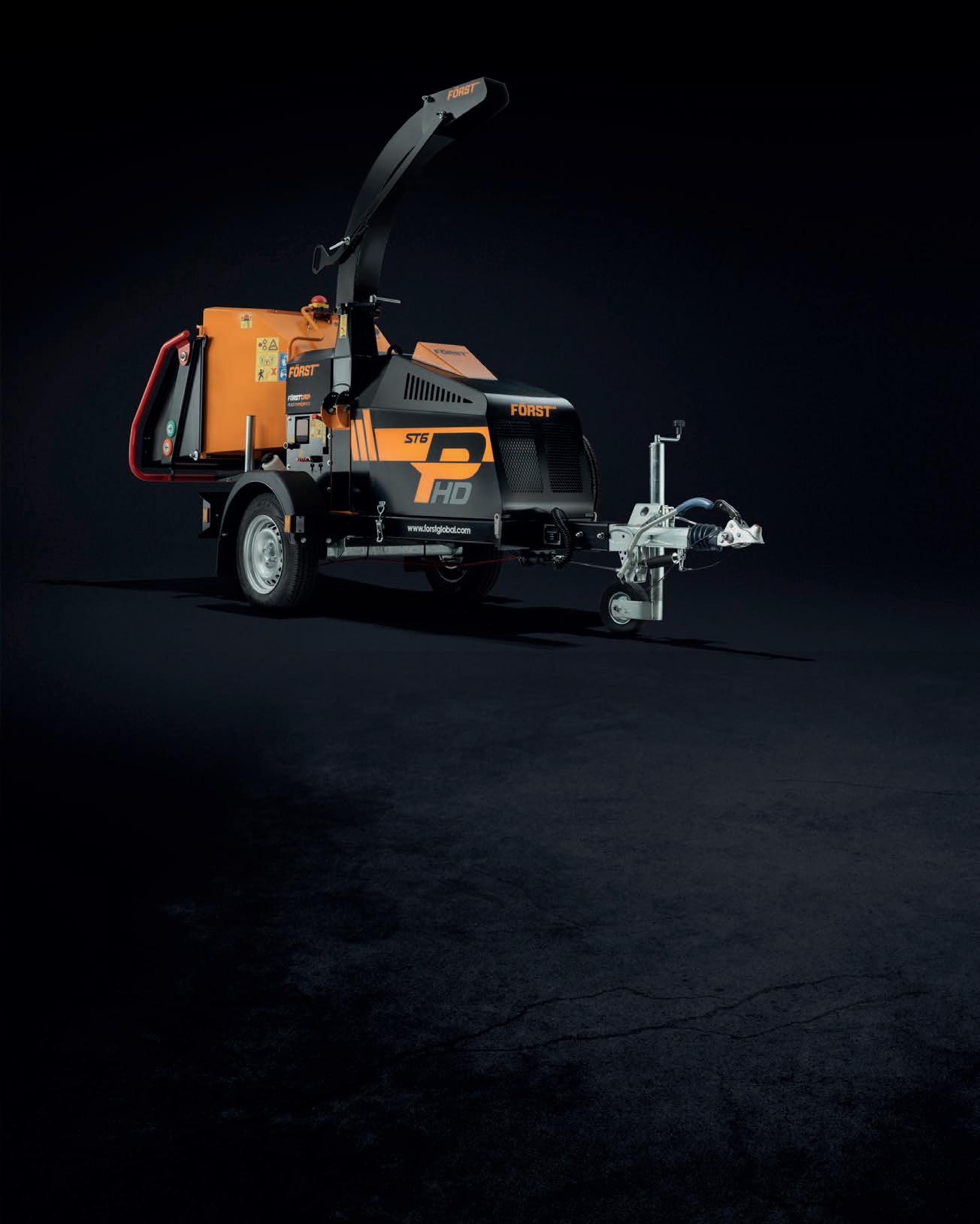
Lantra and Landex have announced the inaugural Land-based & Environmental Learner Awards, which are being launched to celebrate new talent across a range of sectors, including arboriculture. The programme sees the two organisations working in partnership to recognise the talent, successes, and achievements of individual learners in the land-based and environment industries. They are encouraging land-based employers, colleges, private training providers and universities to recognise and promote their top candidates working in the sector by nominating them for a prestigious award.

The awards are open to individuals who were on programme on full-time or parttime Land-based and Environment courses and Apprenticeships in England between September 2021 and September 2022. In this first year, categories include:
● Arboriculture
● Agriculture
● Forestry and Woodland Management
● Equine and Farriery
● Floristry
● Landscape and Horticulture
● Land-based Engineering
● Animal Care and Management (includes keeper and aquarist/dog groomer)
● Veterinary
● Nursing
● Environmental Conservation
● Game and Wildlife
● Aquaculture and Fisheries
● Sports Turf and Greenkeeping
Further prizes
As well as prizes for the above categories which apply across Private Training providers,
Further Education (FE), Apprenticeships Awards (Level 2-3), Higher Education (HE) and Higher Apprenticeship Awards (Level 4-7), there are also prizes for Apprentice of the Year, Inspirational Mentor/Trainer, Overall Winner and Runner Up.
Enter online
Online entries are being encouraged, as the quicker and more sustainable option. However, paper copies of the nomination form are available on request. The deadline for entries is 21 July 2023.
Seeking nominations
Nominations are sought from employers, colleges, private training providers or universities by using the Online Application Form. The winners will be announced at the first prestigious awards ceremony at Reaseheath College, one of the UK’s leading land-based colleges based in Cheshire, on 22 November 2023.
Dr David Llewellyn CBE, Lantra’s chair of trustees commented: “Whilst the headlines may concentrate on the important topic of a lack of qualified individuals and skills in the land-based and environment industries, we think the equally important abilities and
achievements of those thousands of learners who are dedicated to helping grow our workforce of tomorrow, are both celebrated and rewarded.
“Lantra is committed to promoting the land-based and environment sector as a great place to work and forge a fulfilling and long-term career and we’re confident that employers, colleges and learners alike will be equally keen to shine a well-deserved spotlight on our future industry stars”.
Marcus Clinton, chair of Landex added:
“I’m delighted these inaugural awards are taking place. There is so much amazing talent across the network of land-based colleges and universities who are doing such a great job supporting the land-based and environment sectors and employers with their workforce of tomorrow. Being able to shine a light on and recognise the hard work and achievements of our students will make for a very special evening.”
Lantra is an independent, awarding/ accreditation body which exists to help the land-based and environment industries meet their skills needs. It develops and certifies specialist training and qualifications for a range of industries.
lantra.co.uk
Landex – Land Based Colleges & Universities


Aspiring to Excellence
– is a subscriber organisation with 36 member colleges and universities in England and three members in Wales, Scotland and Northern Ireland. landex.org.uk



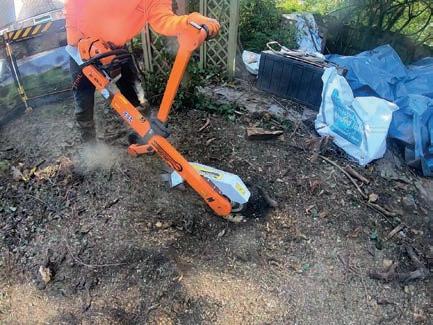

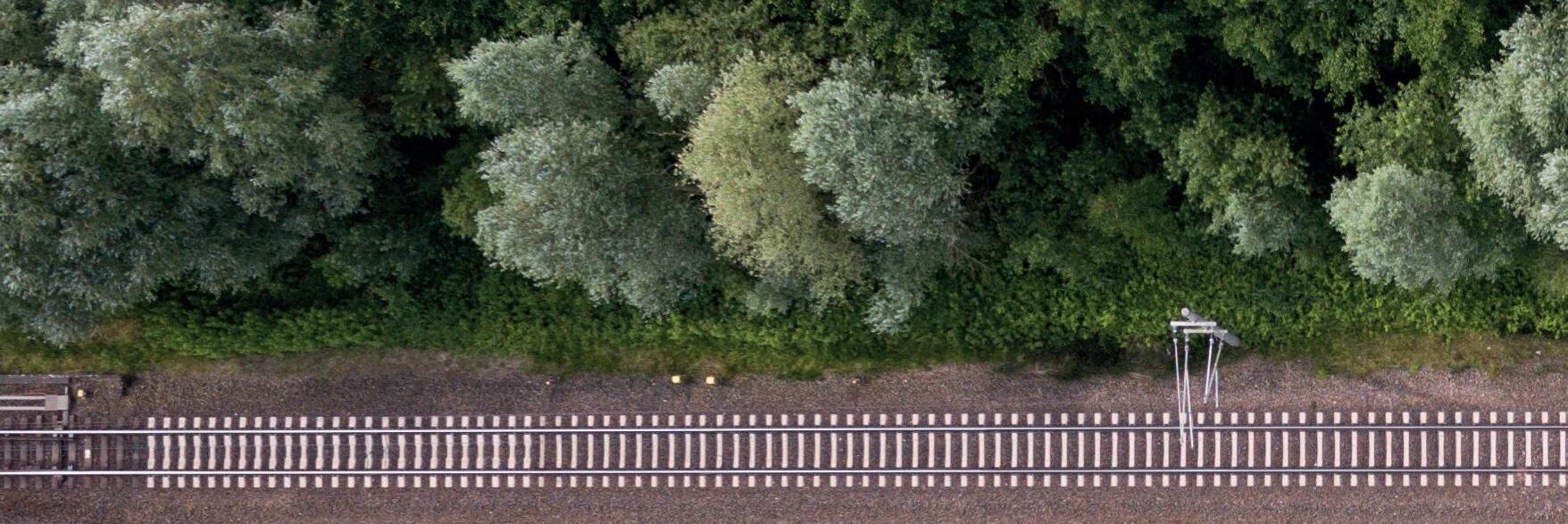
Arboriculture can be challenging work and VMS often works in some of the most demanding situations around –yet, it also has an exceptional safety record. Head of department Steve Procter has worked for the business for over four years and is responsible for all contracts in the north of England, from the initial quote to signing off the
final work. He has over 22 years experience in arboriculture and explains this makes up the largest part of VMS’s workload, although it also provides a range of other services. These include grounds maintenance, landscaping, ecological surveys and site clearance, including dealing with invasive species such as Japanese knotweed.
Steve had previously worked with VMS founder and managing director, Rob Mallett, who invited him to join the young business, which was founded in 2017.
Since then, he has founded a team of some 20 arborists who work out of Rotherham and who take on some of the toughest jobs going.

“We specialise in working in water, on construction sites and alongside railway tracks. It is often high risk work, with hazards including deep water, electrification and heavy equipment on sloping and uneven terrain. That said, I’m proud to report that there have been no RIDDORs in five years.” RIDDOR is the HSE’s reporting of injuries requirement for employers.
Contracts often require longer risk assessments for standard arb work including using chainsaws when working from powerboats and having emergency evacuation and rescue procedures.
Steve is one of the highest qualified professionals around and has a Level 6 diploma in Construction, alongside Level 3 diplomas in Arboriculture and Business Management for the environmental sector, together with a host of qualifications in health and safety and using a range of specialist equipment – he is also a technical member of the Arboricultural Association and is qualified to carry out tree surveys.
But working with trees came about by chance. “I was initially studying law at sixth form college in Barrow-in-Furness but had always enjoyed outdoor activities such as rock climbing. A friend had taken on a job in tree work and it was through talking to him that I realised it was something I would also enjoy. So, I switched to Myerscough College to study arboriculture.”
It is often high risk work, with hazards including deep water, electrification and heavy equipment on sloping and uneven terrain
In his current role, Steve has played an essential part in developing the strong safety culture. “It’s core to VMS and it starts in the induction phase. We also make sure that everyone participates and even those in the most junior roles can make recommendations on how we can work as safely as possible.”
In terms of kit, VMS uses Stihl equipment and has also invested in GreenMech’s EVO wood chipper fleet, including tracked models which are suited to railway embankments and the company also uses MEWPs, mobile winches, stump grinders, excavators and plant with timber grab attachments when necessary. The business has invested heavily in its fleet over the past five years, spending in excess of £2.5 million. This is certainly not work for the
faint-hearted but Steve explains he has a solid and loyal team in place with minimal turnover –this is despite the recruitment challenges that exist across the industry.
“We take on some experienced arborists, but around 50% of our people have had no experience in the sector and we train them from scratch. We have plans to launch an apprenticeship programme this year with 11 places – they will attend college part time and we will ensure they have a solid career path, along with paying them a bit above the legal minimum.”

In terms of finding the right people, Steve says individuals need to be strong and determined personalities as well as being physically fit. “You need to love tree work and be prepared to work in some very bad weather. You also need to be able to follow safety instructions to the letter.” He adds that VMS is committed to internal promotions wherever possible, which means those lower down the ladder can see that moving into a supervisory role is achievable. “We talk about what we can offer to local colleges and also have a mentoring scheme that works well,” he adds.
In 2020, VMS launched a specialist training division – VMT – to ensure its people could benefit from high quality specialist training. This has taken off and while it was initially set up to provide in-house training, it now also offers this to external companies. “It’s a great resource for us and we train people at all levels. I’m passionate about CPD and have seen all too often that bad habits can set in if you don’t attend refresher courses and so we make training an absolute priority for everyone.”
As VMS continues to expand, so too does the option to move into different roles. “Some really enjoy being very hands-on, but there are more management roles developing and specialist roles such as tree surveying.”


It is only a few years back that VMS started with two Ford Transit vans and two wood chippers, along with three employees – it now has over 100. The business is now flourishing and is one of the fastest developing specialists, operating from three depots, and with annual revenue of over £15 million. It may be a risky business to operate in, but Steve and his team at VMS, have shown that putting safety first is also the right strategy for business success.
For more information on VMS, please visit: vmsltd.net
we make training an absolute priority for everyone
OWLS ARE UNDER THREAT THROUGH LOSS OF HABITAT AND CLIMATE CHANGE BUT ARBORISTS HAVE SHOWN THEY ARE READY TO ACT AS WILDLIFE CHAMPIONS AND SAVE THESE PRECIOUS BIRDS
There have been many incidents of arborists scaling trees to rescue forlorn felines who have climbed up and then found they are unable to come down again. But, a couple of recent cases show that some lucky baby owls now also owe their lives to these heroes.


In Norfolk, two baby barn owl chicks were saved when they were spotted just before the tree they lived in was due to be felled. The ash tree suffering from severe dieback was surveyed by Ben Boyce, who runs arb firm Treefellas in Diss. He comments: “We went to fell a customer’s tree and he mentioned there could be a squirrel in there and could we check.

“I abseiled down and looked into a cavity at the back of a tree, and
thought the creatures did not look like squirrels so I took a video for a better look.”
He then realised it was two baby barn owls who were hiding in a hollow inside the ash tree. “I’ve only seen owls a few times in my career of 22 years and it’s definitely not something you see regularly. We always carry out a wildlife risk
assessment from the ground, but if we suspect there may be a nest inside a tree, then we do a more thorough investigation.”
After talking to the client, it was agreed the tree should be left intact until the baby owls are ready to leave and find another home.
Meanwhile in Pett, East Sussex a baby tawny owl was found ‘cold and alone’ after falling out of a tree. Described as a ‘ball of fluff’, the owlet was found by a walker on woodland and taken to the RSPCA
Mallydams Wood Wildlife Centre in nearby Fairlight. He was swooped on by the parents, but was unsure which tree was the right home or if the parents would be able to care for the bird on the ground.
According to the charity’s wildlife assistant, Ash Peter, the owlet was “very cold, quiet and unreactive”. She was checked over and was found to
be uninjured, so given fluids and chopped up meat. She was then placed in an incubator overnight to warm her up.
RSPCA staff realised she needed to return to her nest, but the right tree then needed to be traced. Ash said: “He knew the parents were around, it was just a case of pinpointing which hole in which specific tree the owl’s nest was.”


tree, ascending into the higher branches using ropes. Once he was in position, the owlet was put in a special bag, and with the help of a pulley, was lifted up the tree until she reached the patiently waiting tree surgeon.
“Having been advised on how to handle the little bird by us, he gently removed the owlet from her travel bag and placed her just in the entrance to the nest. She soon jumped down into the nest inside the hollow of the tree and didn’t reappear. It was such a happy moment for all of us. We are confident that the owlet has settled back into the nest with her parents. There is nothing better than successfully
Owls are nocturnal and are in two families – barn owls (Tytonidae) and typical owls (Strigidae) and they can be found on every continent except Antarctica. Typical owls have large heads with round faces, while barn owls’ faces are heart shaped.

However, on returning to the wood, it was found that the hole was 30 feet up, so would be extremely difficult to access.
RSPCA Mallydams staff put out a plea on Facebook for any arborists who might be able to help and within a few hours they heard from Bexhill-based APS Tree Surgery and Fencing, which is run by Andy Stephenson.
The owlet was transported back to the wood and Ash explained: “After double-checking that they had the right hole in the right tree, the tree surgeon, a skilled climber, scaled the
returning a wild animal to the wild where they belong. It was the perfect rescue but without the help of some local heroes, the outcome could have been very different.”
Owls are under threat – of the 16 species of barn owls, four are considered vulnerable, one endangered and one data deficient as there is not enough information to determine its risk of extinction. There are 227 species of typical owls, 24 of which are vulnerable, 13 endangered, and three critically endangered.
They face numerous threats including loss and fragmentation of their forest habitat, food shortages and risks from more extreme weather conditions.
Owls are carnivores and can live up to 30 years – a group of owls is known as a Parliament.

These birds are excellent hunters, and because of their powerful sight ability and huge eyes they can see in the dark. Bristles around their face allow them to detect close objects too. They can fly almost silently, allowing them to catch prey such as small mammals, reptiles and insects.
Owls tend to nest in abandoned nests or use tree holes and empty buildings. Eggs take up to 32 days to hatch and the female remains with them, with the male bringing her food. Chicks are competitive and some young do not survive in the nest because of a lack of food. At around two months old, they leave the nest and experts believe that only about half will reach their first birthday.
It was the perfect rescue but without the help of some local heroes, the outcome could have been very different
The Woodland Trust has announced that extensive tree planting will mean the restoration of an “entire ecosystem” on land that is currently barren. Snaizeholme is 20 miles north of Settle and is close to the Ribblehead Viaduct in the Yorkshire Dales National Park. The area was once covered in trees many hundreds of years ago.


Despite this, many enjoy the open landscape and the plan is to ensure some of this remains. After the last ice age 10,000 years ago, 90% of the Yorkshire Dales would have been wooded, before settlers began to clear the forest for dwellings and farming. Currently, just five per cent of the Yorkshire Dales has tree cover and just one per cent of this is ancient woodland, which is the most favourable for wildlife.
Woodland Trust estate manager Al Nash, says the project does involve extensive planting, but it will not be about covering the area with trees. He explains: “We’ll be creating a mosaic of existing habitats, including open riverside pastures, upland peat bog and acid grassland along with woodland and scattered montane scrub so although the landscape will
change, the variety of new trees and shrubs linking these habitats will definitely make it more attractive – to wildlife and people. We will ensure the habitats transition gradually, integrating them carefully into the landscape.”
As for the types of tree that will be planted, Al says: “We’re looking at a real mix; from patchy scrub to taller trees such as Scots pine, oak and birch to create varied structure in the landscape. They’ll all be native and sourced only from the UK and Ireland. We’ll be keeping plenty of open habitat too and allowing existing wooded gullies to naturally regenerate. Apart from trees, we’ll also be restoring and caring for over 150 acres of riverside pasture, 250 acres of peatland, and 150 acres of limestone pavement, creating a truly unique variety of habitats in one valley.”
Trees being planted include alder, silver birch, downy birch, willow, aspen, rowan, hawthorn and blackthorn, as well as montane species on the higher slopes and the charity has committed not to use plastic tree guards or herbicides. Despite this, deer, rabbits and sheep can decimate newly planted saplings and the Woodland Trust said it would be using plasticfree alternatives. The trees will also create homes for wildlife, including some which are under threat like black grouse and red squirrels.
This first phase of tree planting has been funded by the White Rose Forest through its
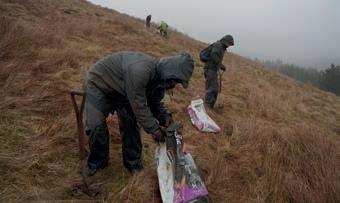
The charity is continuing to fundraise and wants to raise some £8 million for the project, which is expected to take several decades and cover a site of 561 hectares (1,386 acres).
Planting of the first 100,000 trees is already underway and as years pass, it is expected these bring many environmental benefits including reducing pollution, improving water quality and reducing the risk of flooding.
Trees for Climate funding programme. Trees for Climate, part of Defra’s Nature for Climate fund, provides grants for woodland creation within all Community Forest areas in England.
Snaizeholme has over 270 acres of upland peat bog, which should act as a huge sponge to soak up rainfall and slow the flow of flood water down the valley and into the River Ure.
The Woodland Trust will also be working with the University of Leeds and University of York on the project, and there are several sponsors involved, including Aviva, B&Q, Screwfix and Bettys & Taylors Group of Harrogate. woodlandtrust.org.uk
HUNDREDS OF THOUSANDS OF TREES ARE BEING PLANTED IN THE YORKSHIRE DALES TO CREATE ONE OF THE LARGEST NATIVE WOODLANDS IN ENGLAND
We’ll be creating a mosaic of existing habitats, including open riverside pastures, upland peat bog and acid grassland

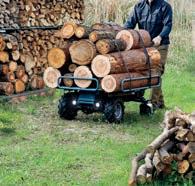
Load up
• The 36V battery-powered wheelbarrow which has a pipe frame carrier, is capable of moving loads of up to 300kg with ease. The brushless motor is powered by two 18V LXT Li-ion batteries in series. It can travel up to 7.2km, when used with 4x BL1860B 6.0Ah batteries.
MAKITA
DCU604 Brushless LXT Electric Wheelbarrow
In control
• Constant speed control automatically applies additional power to the motor to maintain speed under load and the variable speed trigger provides optimum speed control to get around quickly and safely. The handle can easily be adjusted to the position that is most comfortable and the LED lights illuminate dimly lit areas.
• The durable wheels have been engineered to ensure a secure footing and good traction even on uneven terrain. The rear wheel axle is designed to tilt to enable the front driving wheels to keep stable contact with the ground, while the rear wheels can be locked to help to maintain a straight path with heavy loads. When unlocked, each rear wheel rotates independently at 360º for improved manoeuvrability and to allow for sharp directional changes.
Mix and match
Keep on running
• To extend run times, the DCU604 holds four batteries. Once the first pair has discharged, the user switches over to the second set. Users can choose from three forward speeds of either 1.5km/h for walking pace, or 3.5km/h, or 5.0km/h. It also features reverse gear and is capable of climbing a 12° incline, with up to 180kg of cargo.
• The new DCU604 wheelbarrow runs on the same LXT battery platform that powers more than 300 Makita products, so professionals can switch batteries between tools according to the task.

For more information, please visit: makitauk.com

Arblease has enabled many arborists to acquire the essential high-quality machinery that acts as the backbone of their businesses.
A wide selection of machinery and vehicles including wood chippers, stump grinders, tipper trucks, mini loaders, access platforms and excavators are available on the Arblease website, which acts as an online showroom for machinery and vehicles each shown with an example of weekly and monthly costs for a finance arrangement. Powerful and reliable kit is essential for any firm that wants to succeed, and while customers can choose to pay upfront, Arblease gives its clients access to market-leading low fixed rates and helps businesses grow by spreading the cost.
Arblease director Matt Potter explains that the company, a division of Bond Capital Finance, works with a wide range of lenders to ensure customers achieve the best finance products and lowest rates. He says that in the early days, Arblease worked closely with a small number of trusted brands but over the years, has developed a market-leading website that features a wide range of machinery and vehicles from trusted suppliers.
New and used equipment and vehicles are listed free of charge from manufacturers, importers, dealers, and private sellers.
Arblease, based in Northampton, will be 20 years old in 2024. It arranges in excess of 1,000 finance deals a year for UK Arb and Forestry customers. Meanwhile, in the 10

years prior to Arblease’s launch, the group company Bond Capital Finance focused mainly on financing agricultural machinery for farmers.
surgeons. In 2004 we started Arblease and we pushed hard to change this view amongst lenders, even acting as a guarantor for many facilities in the early days. As we grew the tree care industry matured, as did the quality of the businesses. Arboriculture now boasts many successful companies who are keen to expand and are very creditworthy.”
Matt explains: “Traditionally, lenders had been wary about the Arboricultural sector and were reluctant to provide finance to tree
The Arblease proposition is focused on the customer. “We are impartial and do not promote any particular brand or charge advertisers. We are the industry’s leading machinery finance specialists; we always ensure our borrowing rates are among the most competitive and conduct a number of checks on each asset to protect the buyer.”
Arblease gives its clients access to market-leading low fixed rates and helps businesses grow by spreading the cost
These checks include making sure that the equipment is not stolen and that there is no outstanding finance on it. If any anomalies are found, we will withdraw the finance offer and the item is removed from the Arblease website. There are also checks to ensure the valuation is correct, and from private sellers we always require a proof of ownership. “The customer knows they will be buying from a reputable provider and that matters enormously to us.”
Theft is a concern for all arborists who hold stock and Matt says there is a growing determination to tackle this. “In recent months we have attended various ‘Rural Crime Roadshows’ organised by Northamptonshire Police which has given us a shocking insight into this growing problem. To combat this, Arblease offers loans for security solutions

such as trackers, CCTV systems and secure containers where equipment can be stored.”
Arblease’s arborist customers will typically find an item of machinery they want on the website (or they can source it themselves from any supplier or private seller) secure a finance estimate, and apply for finance online in minutes. However, Matt says the company also enjoys meeting customers face to face and regularly attends events such as APF and the Arb Show. “We’re always on hand to discuss and view the most popular machines and we have plenty of merchandise to hand out too.”
Meeting arborists face to face is also a useful way to gauge what machinery is most popular and to talk about how business is going. He says many arb firms are thriving and while wood chippers and stump grinders are mainstays, a growing number are investing in spider lifts, excavators and mini loaders, which enable businesses to take on larger contracts.
“Basically, there tends to be two types of arborists. Those who are not VAT registered and are choosing to work for themselves and are quite satisfied with staying small – it’s a lifestyle business. They are willing to be on the tools and to climb regularly. Then there are those who want to grow their business, take on staff, allow others to do the climbing, so they will choose to increase turnover and become VAT registered. Both types of business are equally valid, it’s just a different mindset.”
But, he also emphasises that obtaining finance is not available to everyone.
“In the case of a new start-up business, such as when someone is fresh out of college, you can’t take out finance. But, if the business is a new subsidiary, such as an established landscaping firm setting up an arb business, then that’s usually not a problem.”
For the complete newcomers though, Matt offers the Arblease Academy, which provides business advice to those who are starting out. “We help them make the right decisions early and plan for where they want to be in three years time. Once they have gained that solid foothold, they will be in the right place to look at finance and start building up their machinery stock. We also provide them with objective advice on what equipment will work for their firm as this is a vital decision. Choose the right machinery and it will pay for itself.”
He adds, however, that in both cases, it makes sense to use a separate lender to their main clearing bank. “It’s generally not a good idea to use working capital or borrow from your clearing bank and it’s better to have separation, which can provide added security for the borrower and a healthy cashflow.”
Matt says a further benefit with Arblease is our wide choice of products from a large number of lenders compared to most dealers who offer very few funding options and limited finance knowledge.
Matt says he and his team are always readily available to talk to customers.
“We’re the finance and machinery specialists and with so much experience in the market, we’ll do all we can to find the right solution. Looking ahead, we’re also involved in some exciting plans to bring the arb community closer together – I can’t reveal anything now, but all I can say is, watch this space.”
Find out more about Arblease at: arblease.co.uk

The customer knows they will be buying from a reputable provider and that matters enormously
The IPAF Global Safety Report for 2022 emphasised the prevalence of falls from height as a primary cause of fatal accidents during MEWP (mobile elevated work platform) operation. In recognition of the urgent need to mitigate this risk, Nationwide Platforms has raised safety standards with a new solution, Harness ON.
Focused on fall prevention
Current safety protocols require operators to attach a lanyard carabiner to a recognised anchor point within the basket. However, it is still possible to operate MEWPs without properly securing the lanyard.
Harness ON revolutionises fall prevention by permanently shackling its intelligent

induction ring to the manufacturer's designated anchor point. The product is also wired to the machine's control panel, so that when the operator clips the standard lanyard carabiner onto Harness ON, it completes the circuit, granting uninterrupted access to all MEWP functions. This means that for the machine to operate at all, the operator must be fastened in. This approach offloads best safety practices onto technology, making them automatic and mandatory, so that human error no longer leads to accidents.
Harness ON has been designed to simplify safety procedures. With its approach of
‘click, connect, and operate’, operators can adhere to the best practices. It is compatible with all sizes of carabiner clips, eliminating the need for specialised harnesses. Furthermore, it seamlessly integrates with all machines, making it a versatile safety solution.
Harness ON is the result of a collaborative effort between Nationwide Platforms, MEWP manufacturer Dingli, and Control Dynamics Inc (CDI), an aviation specialist and development partner. In addition, Nationwide Platforms gained support from UK contractor Balfour Beatty, which has endorsed the device and conducted trials on major projects, further validating the technology’s effectiveness.
Nationwide Platforms is taking a proactive approach to ensure the widespread adoption of Harness ON, setting a new benchmark in safety standards by ensuring all new vehicles are fitted with the technology.
It has also initiated a retrofitting scheme. As of April 2023, the company has started to install Harness ON onto its Specialist Vehicle (SV) fleet. Additionally, 5,000 boom lifts are currently in the process of being fitted with the technology, with the company aiming to have all machines retrofitted by the end of 2023.
● An unobtrusive and robust addition to safe working at height practices, improving compliance, reducing risk and mitigating human error.
● Simple and easy to use.
● Compatible with all sizes of carabiner clips.
● No need for a specialised harness.
● Compatible with all machines.
● Meets CE, UKCA and ANSI safety standards.
● The MEWP will only operate when Harness ON™ has been connected.
Harness ON technology is compliant with CE, UKCA and ANSI safety standards. Because its induction technology ensures that the MEWP can only proceed with operation once an attachment is confirmed, Harness ON reinforces compliance and automates adherence to safety regulations.
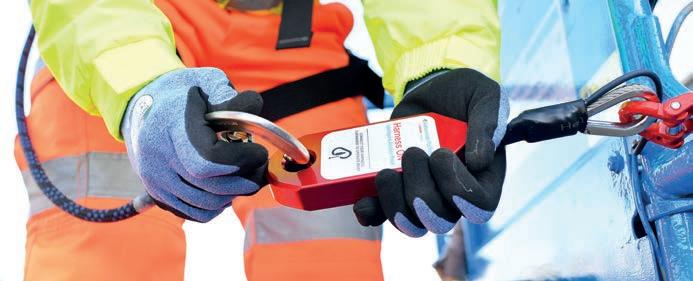
Christopher Houlton, manager for BlueSky Solutions, said: “We are really excited about Harness ON and hope to get as many people exposed to this device as possible. There's nothing else on the market that is quite so wide reaching, with multiple applications across such a wide range of machines. It is the future of safely working at height.”
For more information visit: nationwideplatforms.co.uk
NATIONWIDE PLATFORMS HAS INTRODUCED HARNESS ON TECHNOLOGY TO IMPROVE SAFETY DURING MEWP USE

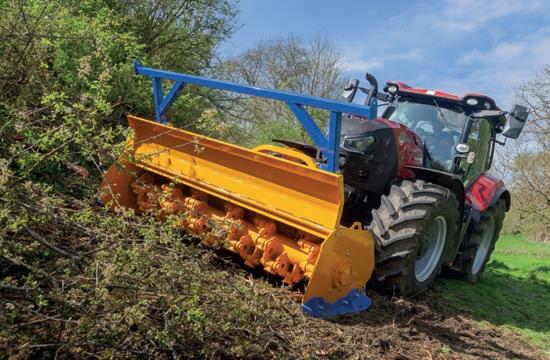
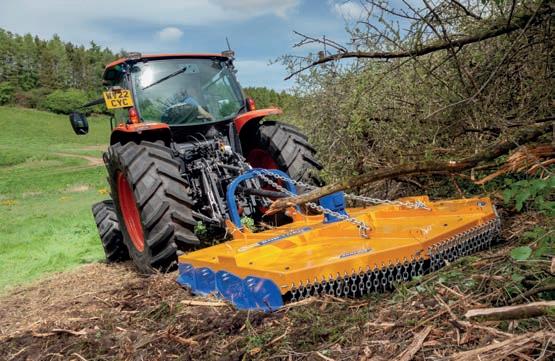
TOP TIPS TO ENSURE YOUR PLANTING PROJECTS SURVIVE AND THRIVE. TREE PLANTING ADVICE FROM TUBEX'S LOUISE ALLEN –JUNIOR KEY ACCOUNT MANAGER AT TUBEX
With ambitious government planting targets – and a growing public understanding of the myriad benefits that trees bring to both urban and rural spaces –an increasingly diverse range of people and organisations are planting trees.
Rewilders, community initiatives, farmers and even financial services companies are all taking part in restoring woodland cover across the UK, to help combat climate change and restore depleted natural environments.
With this in mind, it’s vital to ensure that best practice in tree planting is followed, as many schemes have seen
their trees fail due to poor planning and insufficient maintenance. This was seen recently in Gloucester, where

Whilst there are many ‘how-to’ guides on putting trees in the ground, there is less understanding of the more strategic considerations that need to be made when deciding to embark on a planting project. As a tree protection specialist, we want to share some key advice to ensure that the saplings you plant will survive and thrive into maturity.
thousands of saplings died due to not being watered during a drought – signifying a gap in knowledge amongst some organisations.
Some trees are hardy and will do well in a range of locations whilst others are very picky about where they grow, so it’s important to understand the conditions your saplings are going to be dealing with.
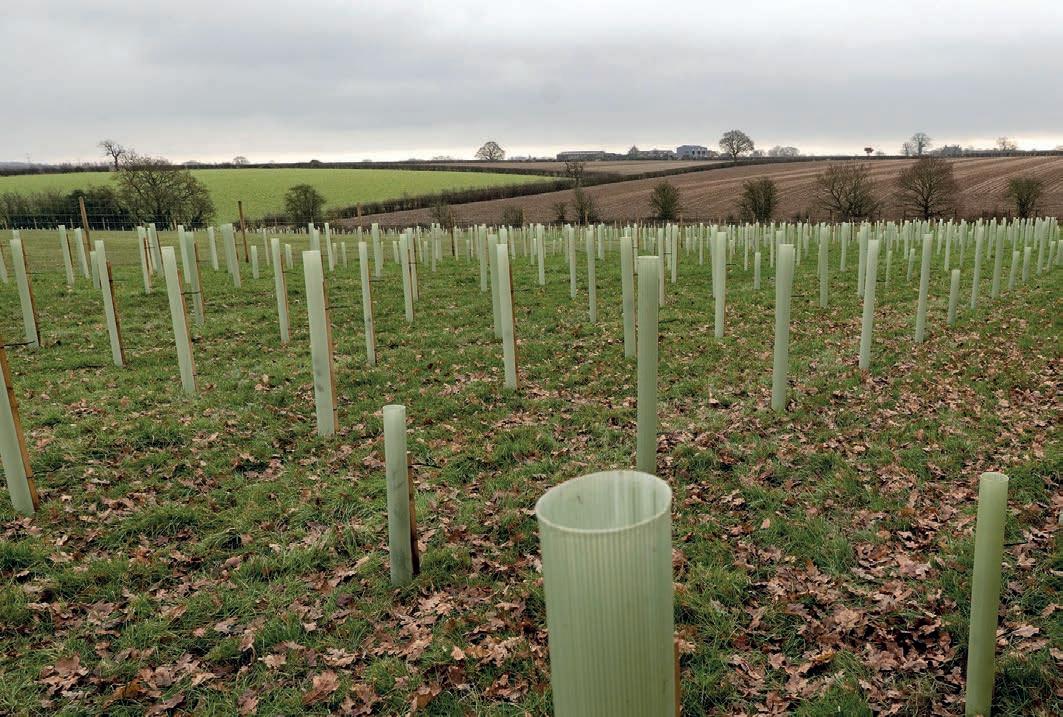
Climate patterns, soil type, moisture levels, drainage and even microclimates are just some of the aspects you need to be aware of before putting trees in the ground.
You also need to understand the particular risks that your location might pose to saplings, such as whether the land is prone to flooding or high wind speeds and plan accordingly.
The most significant and well-known risk is from browsing animals which will eat the saplings before they have a chance to establish themselves with rabbits, voles, and deer being the primary culprits.
See if you have significant populations of these browsing agents (environmental surveys can help with this) before planting to save yourself from serving a free lunch to the local fauna. Equipping yourself with this knowledge then helps to inform...
The Woodland Trust recommends the planting of native broadleaf trees whenever possible and there are some good reasons for this.
Native broadleaves bring some of the most benefit for struggling UK wildlife, providing food and shelter that many animal species have evolved to rely on.
There are more practical reasons too; being easier to grow, more resilient and generally requiring less intervention during their lifetimes.
There are many native broadleaves to choose from however, so use the knowledge of your planting location to inform which specific species you plant. If you are planting along a busy road, then pollution resistant trees such as field maples are a smart choice. Similarly, if you are planting in wet soil then species such as willow or alder are advised.
Look around to see what species naturally occur in the area and take advantage of the many species selection resources out there such as The Woodland Trust or Royal Horticultural Society. Ecological consultants can also provide more targeted advice if required.
Plant at the right time

Saplings do best when planted during the ‘tree planting season’, which is roughly from November to early March in the UK depending on general weather patterns.
This is done because trees and their roots are in a dormant state during the colder months and less susceptible to stress when being transported and planted, giving them a better chance of establishing themselves.
Whilst this is generally considered common knowledge, an unfortunate number of planting projects have experienced high failure rates due to planting outside of this time frame.
Tree shelters’ protection from browsing animals is well understood but tree shelters also help to facilitate faster establishment and growth by providing a beneficial microclimate within the shelter whilst helping to insulate saplings from extremes in weather.
Whilst the use of tree shelters is now widespread, it seems that integrated plans for their end of life is not – with many organisations taking a ‘set-it-andforget-it’ attitude to their use leading to discarded shelters littering the landscape drawing much public ire.
Therefore, a plan for what happens to your shelters once they’ve served their purpose is essential from both a reputational and sustainable perspective.
Saplings are incredibly vulnerable in their first few years. Without appropriate protection measures in place, planting projects can regularly see failure rates of over 50% which leads to expensive and often embarrassing replanting efforts down the line.
There are a range of measures available but one of the most effective is the use of tree shelters which are an effective means of protecting saplings until they are mature enough to survive on their own.
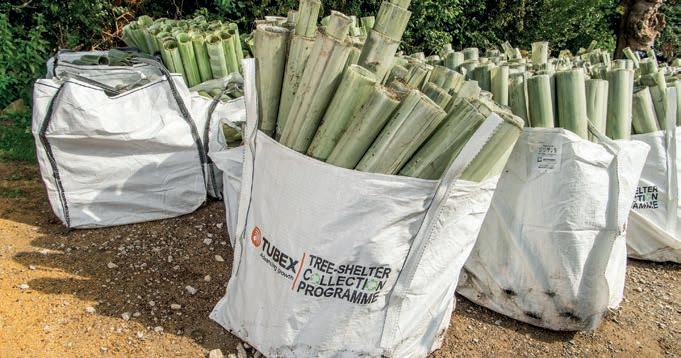
Polypropylene tree shelters can be recycled, which (if containing recycled content at manufacture such as with Tubex shelters) is the most sustainable end of life solution according to current third-party long term cost analysis studies.
In recognition of this, Tubex offers a collection and recycling programme which collects used PP shelters either on site or from a series of collection hubs located across the UK. However, in cases where collection and recycling isn’t possible – using biodegradable tree shelters is a viable option.







HTC Arbor Services, based in Northamptonshire, carries out commercial and residential contracts and is led by founding director Andy Hollingsworth. The company has built up its fleet over the past seven years, bringing on skid steer loaders, miniexcavators and a range of attachments, purchased from RTC Plant Services.
Andy Hollingsworth comments: “At HTC, we have operated in virtually every scenario including residential, local council, new build developers and in the rail and power industries. I must pay thanks to the excellent service and advice provided by Dave Ellis and the team at RTC. Our preference for the high performance of the Bobcat brand mirrors our commitment to providing a friendly and professional service, whilst delivering the highest standard of tree surgery and felling.”
He started the business 16 years ago and the first Bobcat purchase by HTC began shortly after with the purchase of an E26 2.6 tonne mini-excavator which often works together with a tracked wood chipper.
Andy comments: “We prefer compact plant like mini-excavators and compact track loaders because of the access they provide to the restricted and tight areas we are almost always required to work in. There is also a massive productivity advantage - work that would take a gang of five workers a week, we can complete in just two days with three staff.”
More recently, the company has powered its expansion with the acquisition of the Bobcat E55z 5.3 tonne mini-excavator and T76 compact track loader products, while still using the existing E26. The company also has a Bobcat E10z 1 tonne miniexcavator which is used primarily for local council work.
Andy says: “The E55z is often equipped with a tree shearer, allowing us to take on bigger clearance jobs and when working
alongside the T76 fitted with forestry mulcher or stone crusher attachments, we have a selection of equipment to choose from for the projects we undertake.”
The E55z combines engine power of 36.4 kW with a maximum reach at ground level of 5843 mm, which provides agility and manoeuvrability for handling tree limbs and
To ensure optimum performance and comfort, the stability of R-Series loaders has been improved with a longer track footprint compared to previous generation machines.
The T76 compact track loader at HTC is equipped with the optional 5-Link torsion suspension undercarriage which is able to tackle rough terrain. Stability and productivity is enhanced by the optional auto ride control feature, which reduces material spillage and increases operator comfort. All R-Series machines come as standard with a fully enclosed one-piece deluxe cab with HVAC, a 5-inch display and LED lighting system.
branches. To ensure operators can work precisely and safely, the E55z excavator offers panoramic visibility from the cab, with solid but narrow pillars, ensuring the operator is aware of the working area around the machine.

The R-Series Stage V compact loaders like the T76 represent the most significant redesign of Bobcat loaders in 60 years.
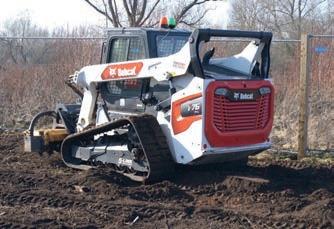
The Selectable Joystick Controls (SJC) system on the T76 offers the Attachment Control Device (ACD) system as standard. Using Can-Bus communication to recognise the attachment on the machine, the system automatically sets up the joystick controls and the output flow to ensure best performance when using attachments on the T76 loader. With the availability of high-flow hydraulics as standard, this further expands the versatility of the machine, allowing it to be used with attachments such as planers and wheel saws.
For more information visit: bobcat.com
AN EXPANDING ARB FIRM IS NOW EQUIPPED WITH A RANGE OF SPECIALIST PLANT TO TAKE ON THE MOST DEMANDING JOBSBobcat E55z 5.3 tonne mini-excavator T76 compact track loader
The GTM Elephant’s Trunk harness is aimed at professionals and suited to arborists who also provide a hedge cutting service. This piece of kit is a sound investment for those who hedge cut on a regular basis, since it helps reduce the risk of injury and muscle strain and allows greater productivity.


Petrol engine and battery-powered hedge cutters are heavy items, particularly when used for long periods and a harness can
Working longer hours? Take extra care
provide valuable protection. This comfortable harness is worn like a backpack and reduces the weight of the hedge trimmer by 3 kg (6.5 lbs). The length can be adjusted and is suitable for hedge trimmers or other handheld machines from 4.5 to 8 kg (10 to 17.5 lbs). A clear view and an unlimited work area allows the wearer to work quicker and with greater safety and improved accuracy.
Meanwhile, the high quality balancer, mounted at the lower back, ensures long lasting
Arborists are prone to injuries and taking on additional work such as hedge cutting can be problematic as it can exacerbate exiting conditions since the work can take hours and be repetitive. Conditions most likely to flare up include:
● Back pain – this often results when there is sustained bending and at worst, can result in a disc injury which usually occurs when too much force is applied through lifting or pulling. It is always recommended to use the hips when lifting or using a wheelbarrow.
● Hand pain – using the same tool for many hours such as hedge or brush cutters is common and may be more severe if the tool user already has an injury or has early signs of osteoarthritis. A tendon problem, known as ‘trigger finger’ results from a swelling developing on the tendon in the palm. This in turn can cause the finger to click and lock, which is frequently painful. Stretching of the fingers can alleviate the problem.
does not get caught in the hedge and offers additional flexibility.
For more information visit: gtmchippers.co.uk
● Tennis elbow affects many who are involved in grounds maintenance work, such as sustained periods of clipping shearing and pruning. The condition causes inflammation and pain below the elbow and is exacerbate by any gripping activity. Wearing quality gloves and stretching and shoulder exercises can help with the condition
● Shoulder pain affects plenty of arborists and is usually due to Impingement Syndrome or Rotator Cuff tears. Impingement is aggravated by sustained reaching up and so a harness and using long reach pruners or cutters can reduce the risk. Rotator Cuff injuries are generally caused by pulling and wrenching and a starter cord on a chainsaw can be a factor.
● Knee and hip pain – excessive squatting, kneeling and bending are all to blame for this and risk can be lessened by keeping knees in a parallel position so they remain aligned.






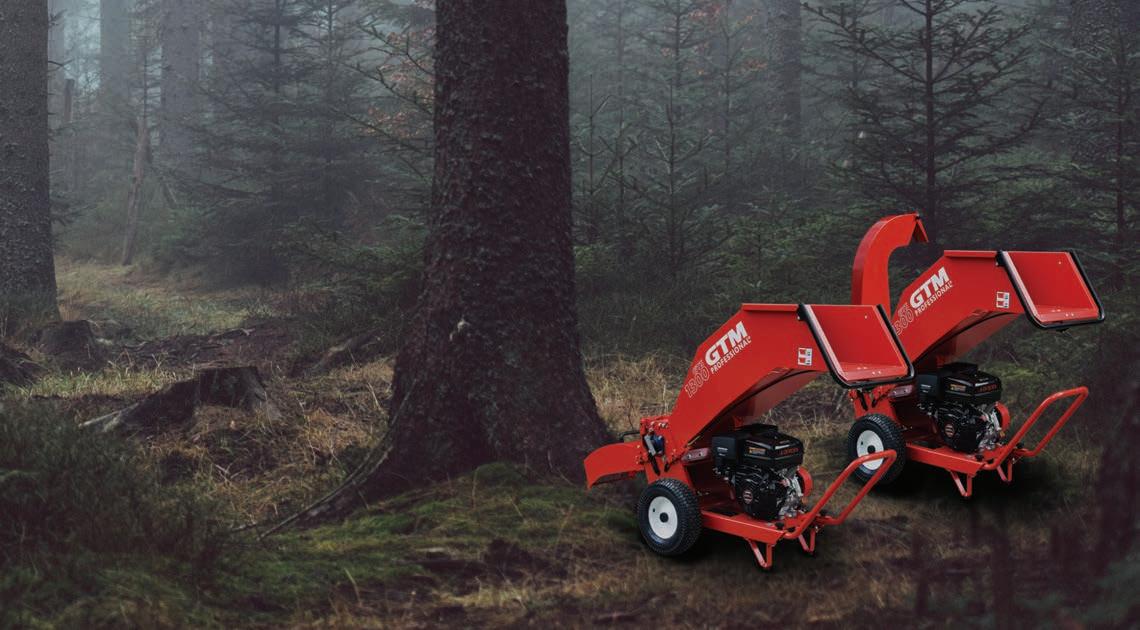
Green Line Arb has developed an app for arborists, along with landscapers, with the aim of linking professionals, the public and specific services connected to the industry. The app has a range of features and an intuitive interface, to help streamline work processes and enhance overall efficiency. It enables users to tackle the daily challenges faced by the sectors by providing a digital and practical combitool.
● Industry map
Features include the Industry Map – this is packed with waste drop points and industryspecific points of interest, such as arb shops, health centres, LOLER inspectors, training centres, equipment hire, and machine repairs, among others. The feature allows the user to filter by service type to quickly find the help they need no matter where they are.
Through the app, professionals can also connect and collaborate with the public, sharing their useful by-products at ‘drop points’ populated from the online recycling portal. The app also serves as a hub for connecting industry specific services, such as LOLER inspectors and training providers with trades people in need.
● Guidance through the blog
Green Line Arb also focuses on demystifying complicated industry legislation and practical operators. Its blog delivers news bulletins and useful information in nutshell form, ensuring that subscribers are up to date on the latest developments.
● Personal profile
Each user can set up a personal profile to showcase their qualifications, experience, and day rate. Businesses can contact the arborist directly with job offers.
● Emergency location
Meanwhile, the emergency location feature helps the user send their exact working location to the office or a loved one, including how long they will be working on-site. This feature is essential for risk assessments and could save a life in an emergency.
● Job adverts
Arborist and landscaping professionals using the app can easily see job postings that are close to their location, allowing them to build their team and grow their business.

● Waste transfer notes
This feature generates electronic waste transfer notes with all the necessary codes, making the process efficient, fast, and effective. Users can also email them directly to the ‘Drop Point’ destination for seamless and hassle-free disposal.
● In-app messaging
Users can directly message individuals or companies when looking for workers or replying to job offers.
● Favourites feature Keeps top services and contacts within easy reach.
“We designed this app to meet challenges head-on, empowering and equipping the arb and landscaping community,” says founder Nick Wilson. “We’re confident that this app will be a game-changer for the industry.”
He adds: “Our goal was to create an app that would be a functional tool for practical people, making our jobs easier, safer, more efficient and more productive.”
Nick continues he has seen at first-hand the recurring obstacles which can hinder productivity. He has many years’ experience of working in both the domestic and commercial sectors and says these can occur time and time again. He says it became clear that these challenges were common across the industry, no matter the size of the company.
The Green Line Arb app is available for download on the App Store and Google Play.

For more information visit greenlinearb.com

We’re confident that this app will be a gamechanger for the industry
THERE IS A SHIFT TOWARDS TAKING A MORE RESPONSIBLE ATTITUDE TO REDUCING CLIMATE CHANGE – SO IS YOUR FIRM READY TO DO MORE?
Like so many businesses, a growing number of arborists want to do more to protect the environment. But, that is not always easy when the main day job often comprises felling trees and all the lack of understanding that can surround this. Of course, very often, there may be good reason why a tree needs felling, such as for a housing development to go ahead or if there is a disease such as ash dieback.
not only stored by the tree and the roots but also held in the surrounding soil. As trees grow they also absorb and lock in carbon emissions that would otherwise contribute to global warming.
What’s the concern about carbon?
Carbon dioxide is comprised of one atom of carbon and two atoms of oxygen, hence being called CO2. Carbon dioxide is a heattrapping gas that leads to an increase in global warming. It is an essential part of the cycle of life, but in elevated levels it results in extreme weather, rising sea levels and a host of environmental problems such as food shortages and increased wildfires.
1992. In broad terms, a carbon offset means reducing or removing greenhouse gases (typically carbon dioxide) to make up for emissions that occur elsewhere.
Some businesses pay to participate in carbon offsetting schemes, others will simply look to reduce harmful activities.
Tree planting tends to be a popular way of offsetting carbon, other methods include installing renewable energy sources or investing in biodiversity and conservation.
Businesses can buy permits – or carbon credits – to support projects to clean up the atmosphere and compensate for the emissions they have not yet eliminated.
Many arborists do not want to fell trees unnecessarily and will suggest alternatives, such as reducing the size to more manageable proportions. If a tree does need to be removed then a replanting service may be offered.
Trees are first and foremost a means of reducing the impact of climate change – just one could remove a tonne of carbon dioxide from the air over its lifetime. The carbon is
It is becoming increasingly common for businesses to talk about their environmental credentials – and this can be a good way for clients to know they are dealing with a responsible company that cares about the environment.
This can be done both in explaining about any practical methods – such as using battery-powered tools – and in being aware of other ways to reduce carbon.
Carbon offsetting was developed by the United Nations at the Kyoto Protocol in
Companies that achieve net zero can be accredited through PAS 2060 – the international standard for carbon neutrality.


It is also common to hear the term ‘carbon footprint’ being used – this refers to the amount of carbon dioxide and other greenhouse gases that a person or organisation generates.
The UK has a target to be ‘net zero’ by 2050, which means achieving a balance between the carbon emitted into
Trees are first and foremost a means of reducing the impact of climate change
the atmosphere and the carbon removed from it. Like other businesses, some arborists will want to reduce their carbon footprint.
Many will run petrol or diesel vehicles and so may take more care when planning journeys and in avoiding energy wastage. Some are ensuring that wood chips are converted into biomass or used as mulch and using solar panels to heat office space, for example, is also environmentally friendly.
If you are running a small business and want to calculate your carbon footprint, there are a number of calculators available – one example is carbonfootprint.com/measure.

The process involves splitting your greenhouse gas emissions into Scopes 1, 2 and 3. Scope 1 is direct emissions such as fuels burnt by company vehicles. Scope 2 is indirect emissions caused by the business buying energy – so from sources they do not control – such as electricity. Scope 3 is optional and relates to indirect emissions linked to business activity such as decomposing waste or employees commuting to work.
Some large organisations will be involved in tree planting on a major scale, such as within global forests. The UK is also seeing more
planting on a significant scale, but even an individual tree for a client is important.
The National Trust, for example, has said it plans to plant some 20 million trees by 2030 and its tree choices may also be of interest to arborists, since it is focused on native species that will offer most environmental benefit.
as oak, beech, lime, field maple, hazel and hawthorn as these help support the existing ecosystem, with ornamental varieties used where appropriate.
There is growing awareness of the risks that come with imported trees and so choosing those from reputable UK nurseries is important. The Plant Healthy Certification scheme, for example, provides a kitemark to show that the sapling has been responsibly grown and as a way of improving biosecurity. According to the National Trust, new native woodlands are likely to include species such
Arborists are typically small firms and will want to ensure that costs on any environmental initiatives are affordable. In many cases, showing a commitment to reducing energy use and switching to batterypowered tools when possible will be welcome measures that show an enlightened attitude. There is also plenty of reading that is relevant for smaller firms – check out the Federation of Small Businesses (fsb.org.uk) which has plenty on the topic. Meanwhile, eBay UK has launched a carbon academy with online learning modules, specifically aimed at SMEs and providing guidance on climate strategies – see ebay.co.uk/sellercentre/grow-yoursales/carbon-academy/
Climate change is a massive subject but it is also one where many arborists should consider growing their knowledge. When it comes to trees, this sector is at the sharp end and so there should be a readiness to both pass on their expertise to clients and do their bit for the environment too.
There is growing awareness of the risks that come with imported trees and so choosing those from reputable UK nurseries is important
What is RA Information Systems and who are the people behind it?
RA Information Systems is a privately owned, family run business founded in 1988 by Rob, Jon and Annette Dabbs. Right from its inception, RA has been offering bespoke software services to a variety of customers in the UK. The company has been successful in the development and implementation of their specialised enterprise software packages; Ezytreev and Clarity Core (a workplace management system) are the main software products created and developed by RA’s in-house team.
Has the business expanded?
Focused on providing maximum support to their client’s operations, RA has expanded the offerings into IT network and infrastructure, data security, connectivity and voice solutions in order to provide our customers with ready-to-operate systems.
Why trees? What were the reasons for entering this market?
It all started in the early 1990s when local UK authority Lichfield, one of the RA’s customers at that time, commissioned them to design a new system to manage their trees and woodlands.
What other sectors do you specialise in?
In 2000, RA expanded their software services creating a software for the business centre industry and innovation lead sector creating Clarity Core, their software that has later evolved into a solution to streamline the management of combined work spaces and laboratory units.
When was Ezytreev launched and what is it?
Ezytreev was launched in 1991, the system is designed to support local authorities, public
and private sectors to fulfil their commitment to manage and maintain their tree, woodland and landscape resources on streets, in public parks and green spaces, on council estates, along highways, public roads, railway networks and coastlines.
Who are the target markets for Ezytreev?
It is primarily used by local authorities including county, city and borough councils and their contractors. It is also used by other large-scale tree managers including housing associations, universities, water companies, zoos, large land owners and independent consultancies.
Why should they choose Ezytreev –what benefits does it bring?
Ezytreev allows users to build their own system to suit their unique requirements, it provides a range of benefits including:
● Sustainable standards of work, review, monitoring, risk assessments and
maintenance procedures across sites in line with industry recommendations and codes of practice.
● Increase in work efficiency and higher processing capacity by automated routine tasks, mobile working and optimised use of resources.
● Closer work monitoring, timely invoicing plus enabled budget planning.
● Prevention of safety hazards and minimised risk of liability for injuries and/or damages to the public and property.
● Optimised communications and coordination between office based staff and those undertaking visits/surveys in the field.
● Data analysis with option to quantify the wider benefits and value provided by trees by using the latest additions of an integrated Tree Carbon Storage & Sequestration Calculator for web interface and integration with the new iTree Eco-Benefits API.
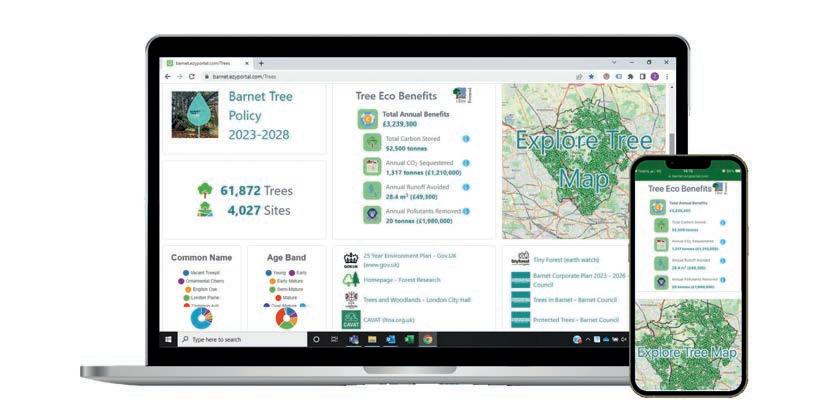
IN THIS Q&A, PRO ARB DISCOVER RA INFORMATION SYSTEMS , WHICH IS BEHIND EZYTREEV , A TREE, TPO AND ASSET MANAGEMENT SYSTEM
Right from its inception, RA has been offering bespoke software services
Overall, the software is well respected not only as one of the most trusted systems for managing trees and open space assets, but also for streamlining TPO and tree work application processes. It is the only system that provides full TPO functionality on-site.
same time reducing unnecessary contact from the public.
A particular mention goes to the London Borough of Barnet Council who during June 2023 are launching their Community Tree Portal that will allow users to identify trees, view a photo and basic information, learn about the eco-benefits each tree provides, any work carried out and submit an enquiry if required. This online platform also allows the locations of upcoming new tree planting to be viewed.

Based in Chesterfield in Derbyshire
Ezytreev has a user-friendly intuitive interface, it is optimised for the use on web, desktop and mobile. The Onsite App gives a great user experience on Android, iOS and Windows 10 devices. Ezytreev offers a Training Credits Scheme which can be used for attending training workshops, online sessions or on-site visits. Customers are also welcome to use the ezyUserGuide platform offering instant access to online resources including user manuals, training notes, video guides, a news blog and a community forum.
EzyPortal is a new Ezytreev product that’s currently attracting a lot of interest from UK local authorities. The portal feeds directly from Ezytreev, and publishes councils’ tree data (Community Tree Portal) or TPO data (Protected Tree Portal) online for self-service access by the public. It is a convenient resource that offers a user-friendly interactive map-search tool and increases community engagement while at the
Another council has recently completed a project to digitise their existing TPO records and establish end-to-end paperless TPO processes. Working in conjunction with the Ezytreev team on developing ezyPortal, it now provides a self-service portal that offers a simple-to-use tool where householders, solicitors and others can check the protection status of trees by searching for a property and viewing TPO trees, Conservation areas and any s211 trees on mapping. Fed directly from Ezytreev, ezyPortal publishes Councils’ TPO and application/notification registers, offers a user-friendly interactive map search tool and a dedicated tree works applicant resource where anyone can use a simple wizard to populate their application form, schedule of proposed work and generate a sketch plan.
A further new use for Ezyasset (Ezytreev’s asset management module) has also arisen following publication of the government’s long awaiting ‘Biodiversity Net Gain’ requirements under the Environment Act 2021.
RA Information Systems has grown from being a small start-up to a recognised company, with over 30 employees, and for bespoke software services - and it continues to experience growth.
Annette Dabbs, company director, commented: “We are delighted to have reached this milestone, especially in such a competitive marketplace. We’re pleased to have become a part of the UK business community and have had the pleasure of working with and meeting many professionals over the years and look forward to continuing to build on these strong relationships in the future. It was great to celebrate our 35th Anniversary with our employees and friends this May and we’ll continue celebrating it throughout the year with more events to come.”
These will require all development to deliver a measurable biodiversity uplift of a minimum of 10%, either on or offsite, with local authorities and other land managers having the opportunity to benefit from this by providing off-site opportunities for developers to fund biodiversity net gain, through enhancement of
Ezyasset is the ideal tool to support land managers in mapping, assessing, managing and periodically reviewing the condition of their habitats. We already have local authorities getting underway with carrying out habitat condition assessments with Ezyasset, in readiness for Biodiversity Net Gain becoming a requirement from November 2023.
Ezytreev allows users to build their own system to suit their unique requirements
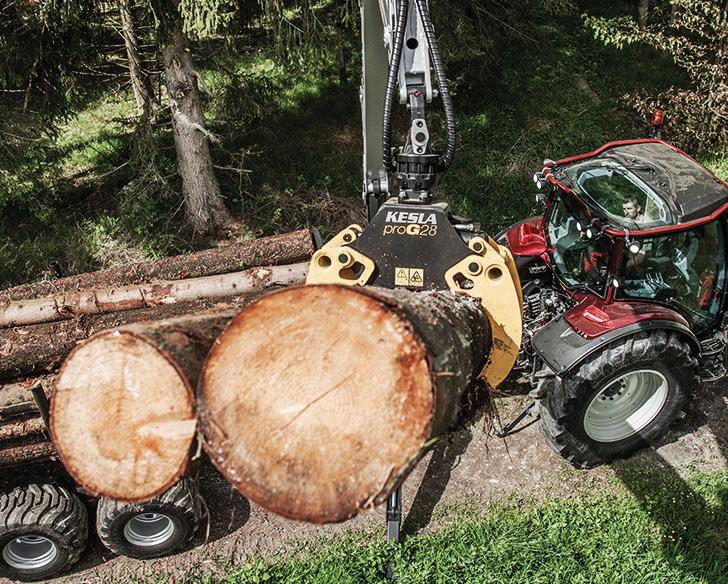







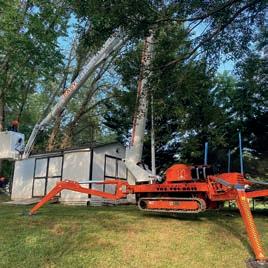

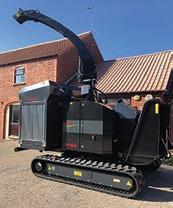
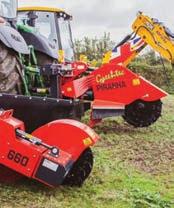




Hinckley and Bosworth Borough Council is looking for independent and self-motivated arborist climbers to join the Green Spaces team. Our arborist climbers play a vital part in the care and maintenance of trees at parks and green spaces across the borough and applicants must be committed to improving public open spaces and working with local communities to make a positive difference to a high profile and priority service of the council.


Location: London
To help the council manage and maintain Haringey’s trees, it seeks someone to provide professional advice and support on all tree related matters in accordance with Council strategies, current legislation, industry-best practice and published guidance. You will also assist with the coordination of all matters relating to the procurement and monitoring of tree maintenance in the borough, maintaining close working relationships with a range of stakeholders including other council services such as Highways, Parks, Haringey Homes, in addition to residents, contractors and councillors.


What does your role involve?
I talk to industry bodies and work with them to create practical solutions for their training and qualification needs.
How long have you worked for Lantra and what did you do previously?
I’ve been at Lantra now for six years.
Prior to this, I worked for a couple of other awarding bodies including ABC Awards (now SEG) where I managed the arboriculture qualifications.
How would you describe yourself in three words?
Enthusiastic, sociable, happy.
Why do qualifications and training matter?
They are important as they’re used as currency within the sector to show that you’ve acquired the competences to complete work tasks. They’re the start of your professional journey in the industry.
They’re also mandated in PUWER and the AcoP, PUWER regulation 9, states that all employers must ensure employees are trained for the equipment they use and qualifications are also mandatory for certain areas.
Which courses are flying off the shelves at the moment?
We’ve seen an increase in the take-up of many of our courses in the last couple of years. Basic Tree Survey & Inspection is one and this is good because it shows that
people and organisations are beginning to take ownership and responsibility for the trees on their land. We’ve also seen a big increase across the board in our chainsaw suite too.
through the next generation of arborists and ensure that improvements in the safety of the industry can continue to improve.
Do you think more needs to be done to raise awareness of trees?

Yes, it really does. Living at the heart of HS2 and seeing the destruction of trees along the route, along with the hundreds of thousands of dead trees that were supposed to be planted to replace them, indicates that more needs to be done to show the impact the developments are having on our green spaces and how it can be better managed.
How have you developed your knowledge of trees and tree work?
I’ve worked closely with the Verifier team at Lantra and listened to their expertise to develop my knowledge, along with a number of the Instructors too. On top of that, I have completed training and qualifications myself to get a better understanding of the area/ profession. So far, I’ve done the chainsaw maintenance, cross-cutting and felling up to 380mm, followed by the Lantra assessments and I’ve also done the Basic Tree Survey & Inspection.
Should more arborists consider becoming instructors and assessors –what are the benefits?
Yes, I do. Becoming an instructor and/or assessor gives you the opportunity to bring
Do you enjoy meeting arborists face to face and how useful are events such as APF and the Arb Show?
I do – I’m a sociable person and like to hear different perspectives on things. APF and the Arb Show also give me an opportunity to hear from people directly, including instructors, providers and learners who are taking the courses to hear about the positives and things we can do better in our courses. The more feedback we get, the more improvements we can make.
How do you like to switch off when out of work?
Running is my main way to switch off. Nothing clears the head better than getting the trainers on and spending an hour or so running through the local country lanes.
Becoming an instructor and/or assessor gives you the opportunity to bring through the next generation of arborists
A.W. Jenkinson Forest Products provides a broad range of on-site clearance, forwarding and chipping services for forestry, construction, tree surgeons and land owners. From small one-off jobs to large chipping contracts, whether at the roadside or deep in a forestry plantation, we can meet your site requirements and tailor our services to your needs.
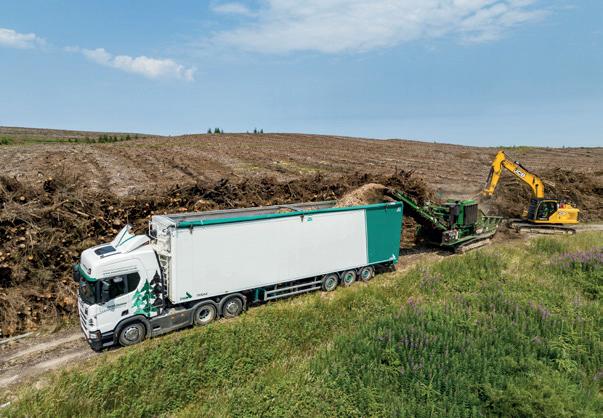





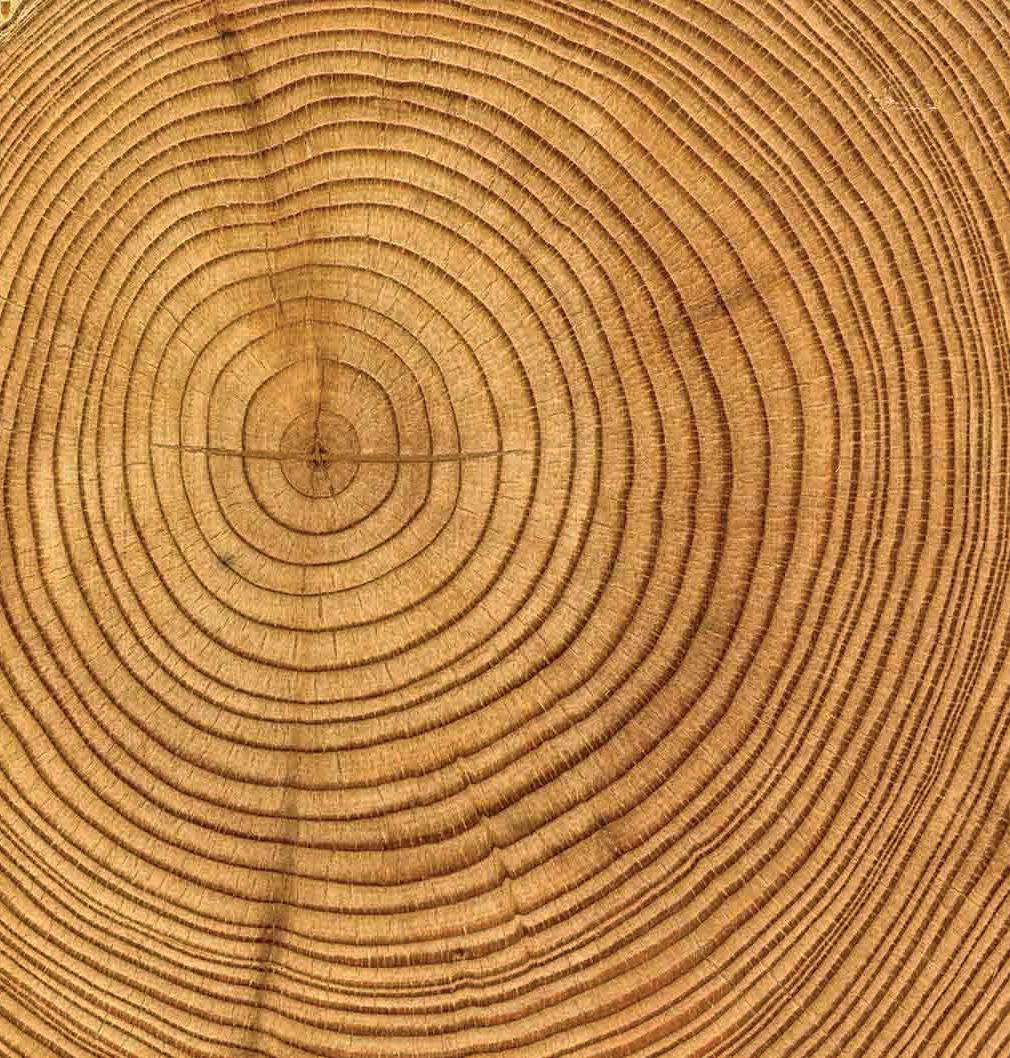
more information, contact us now: email arb@awjenkinson.co.uk or
